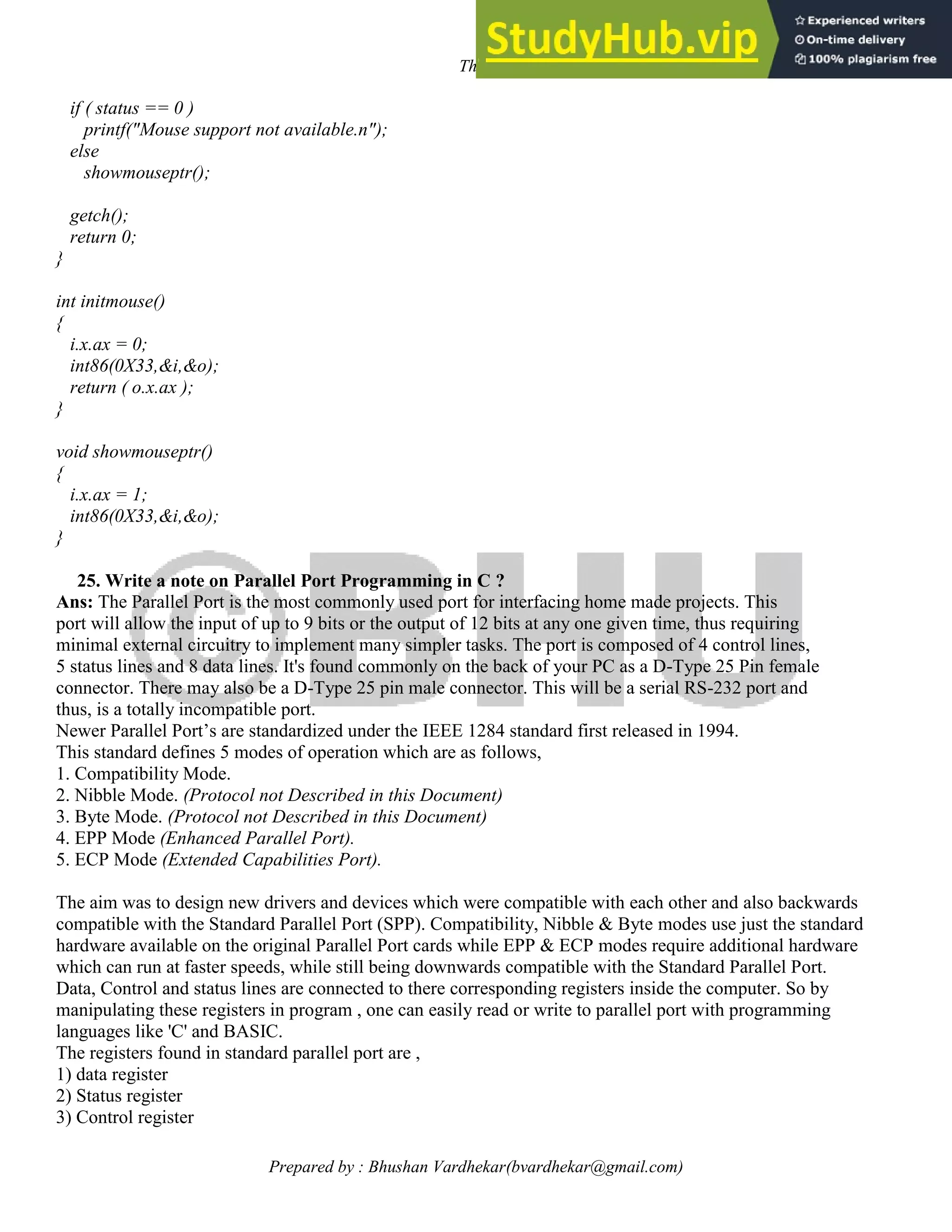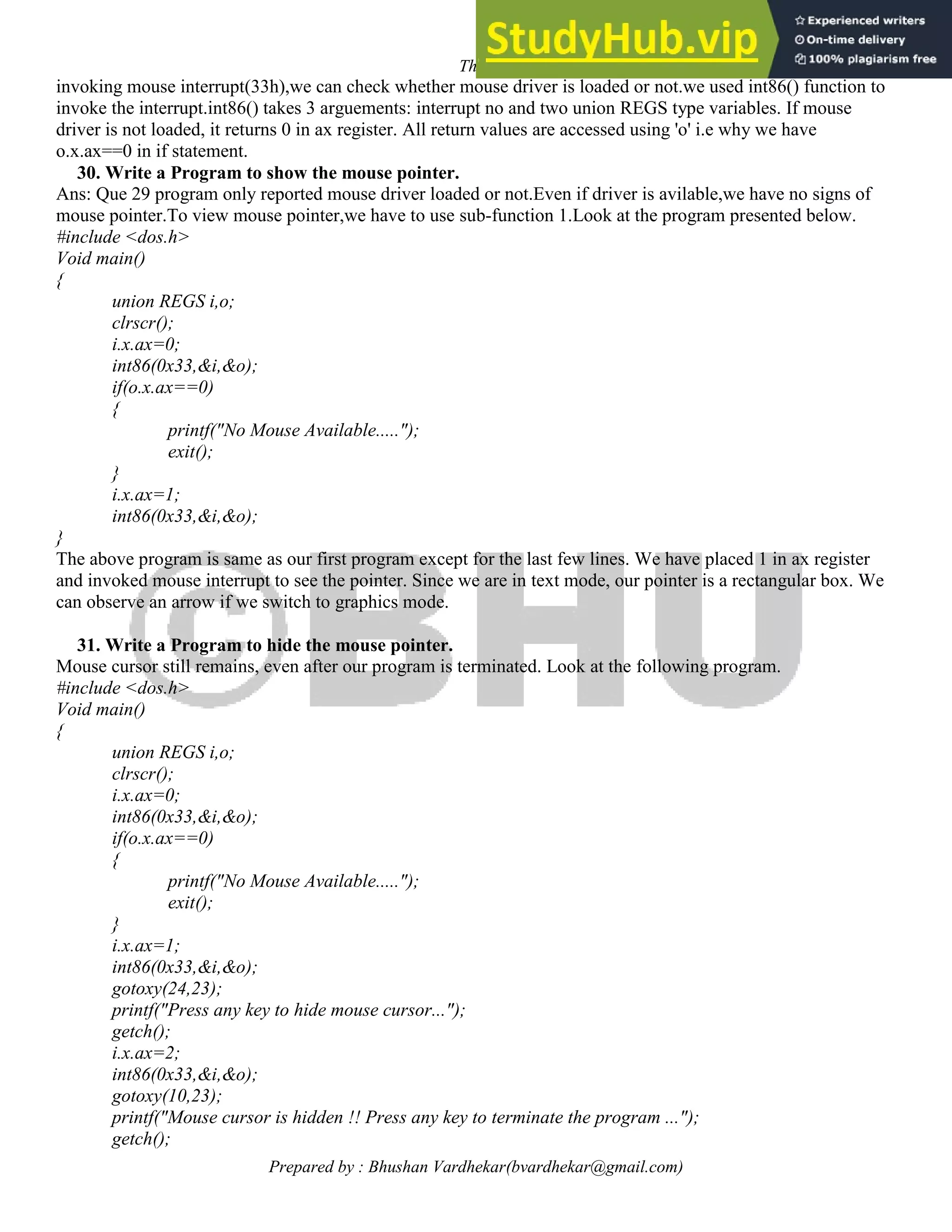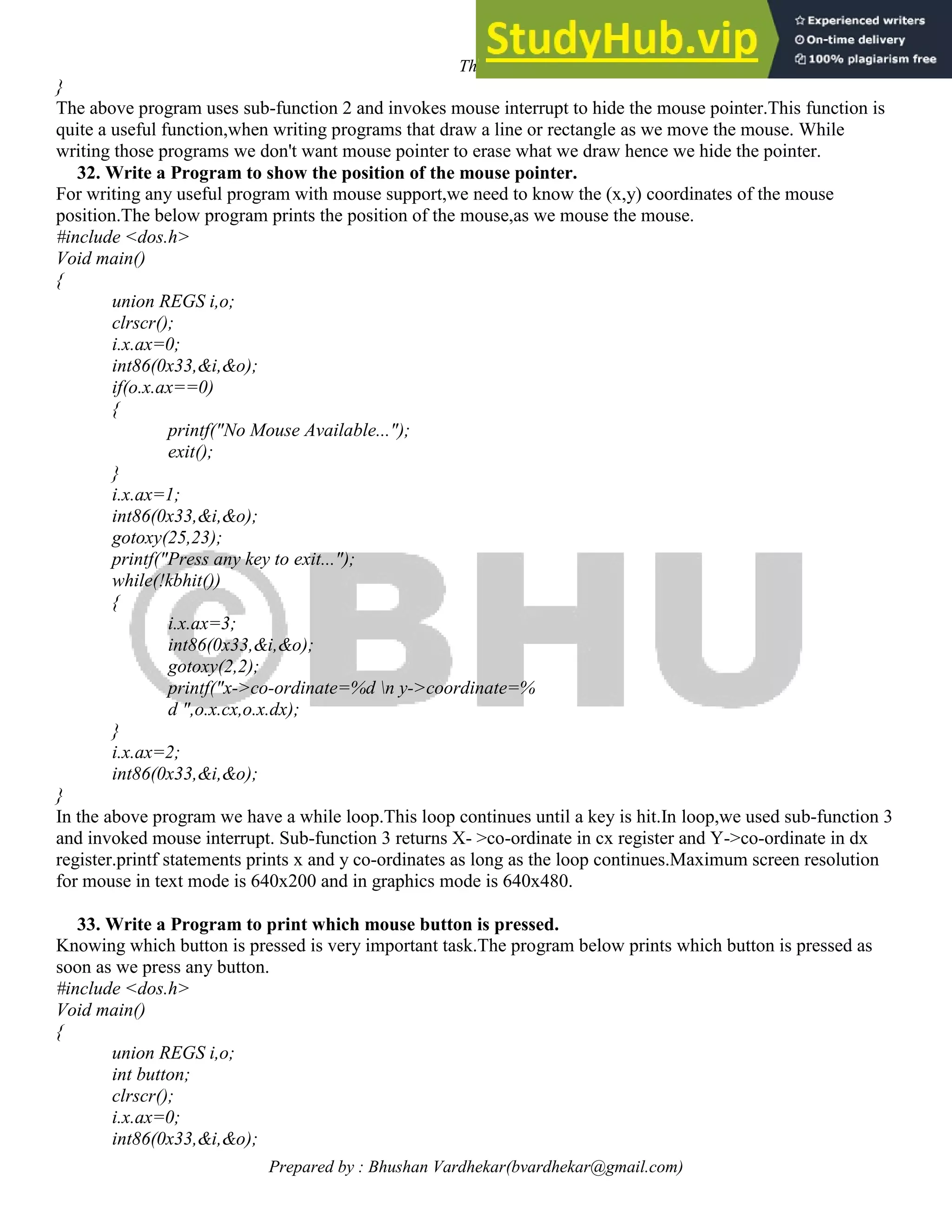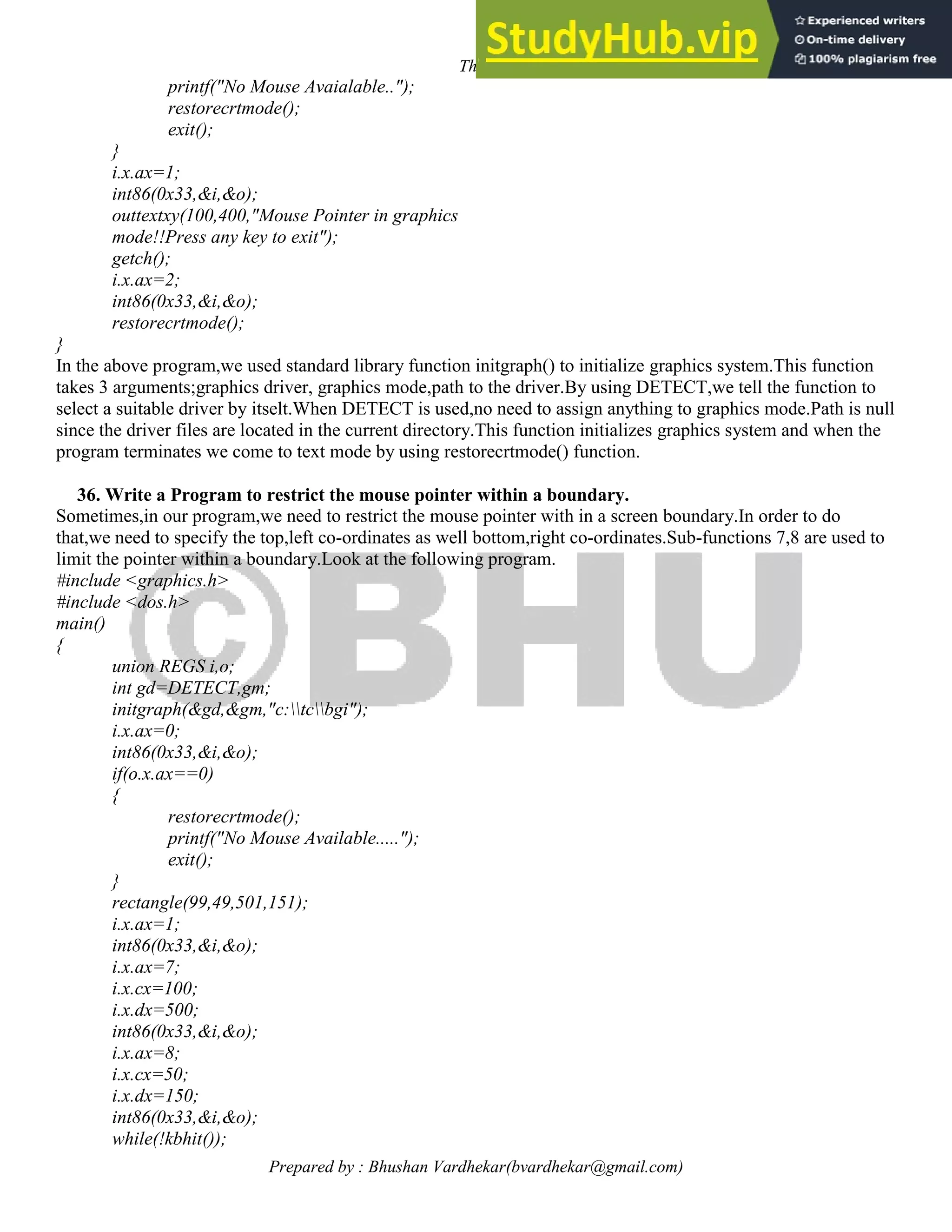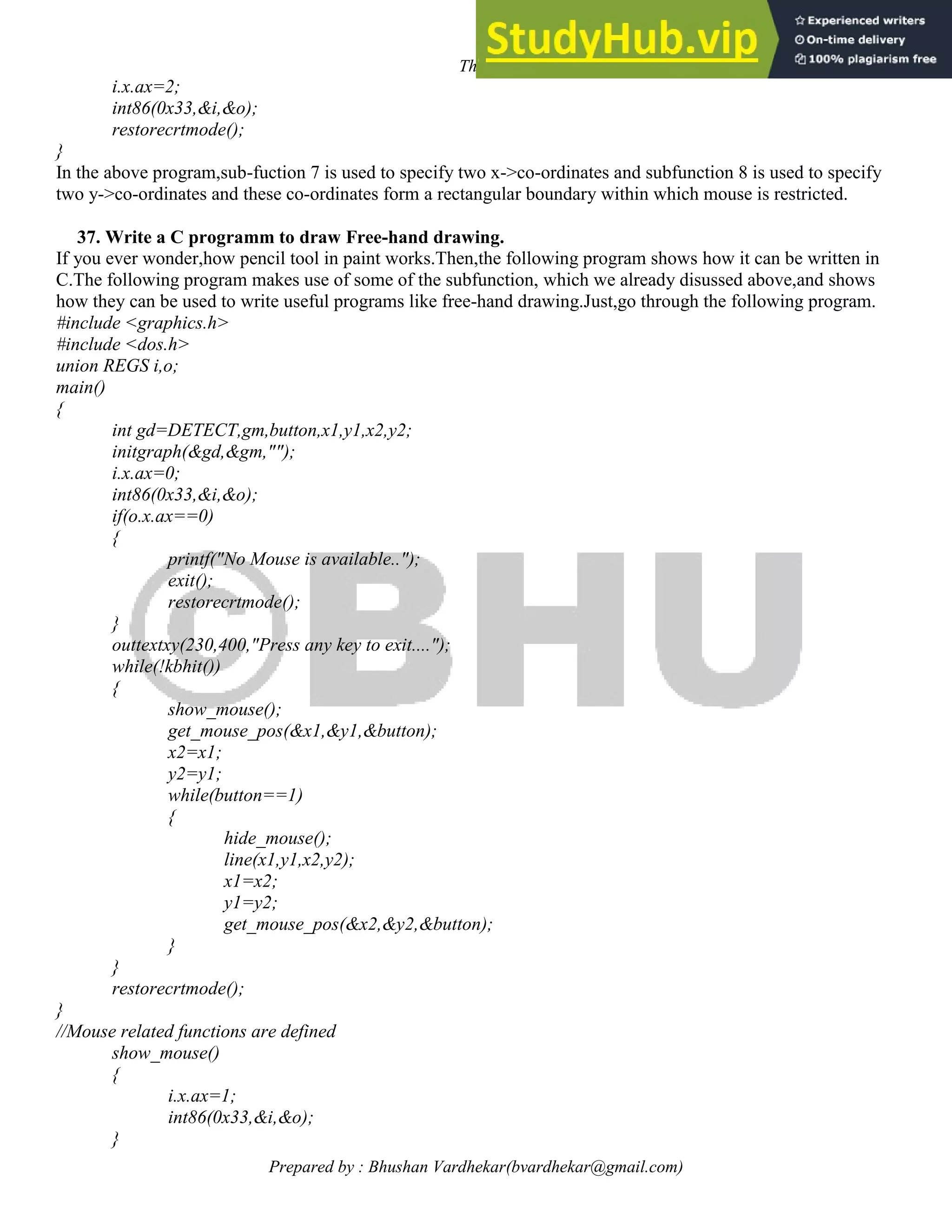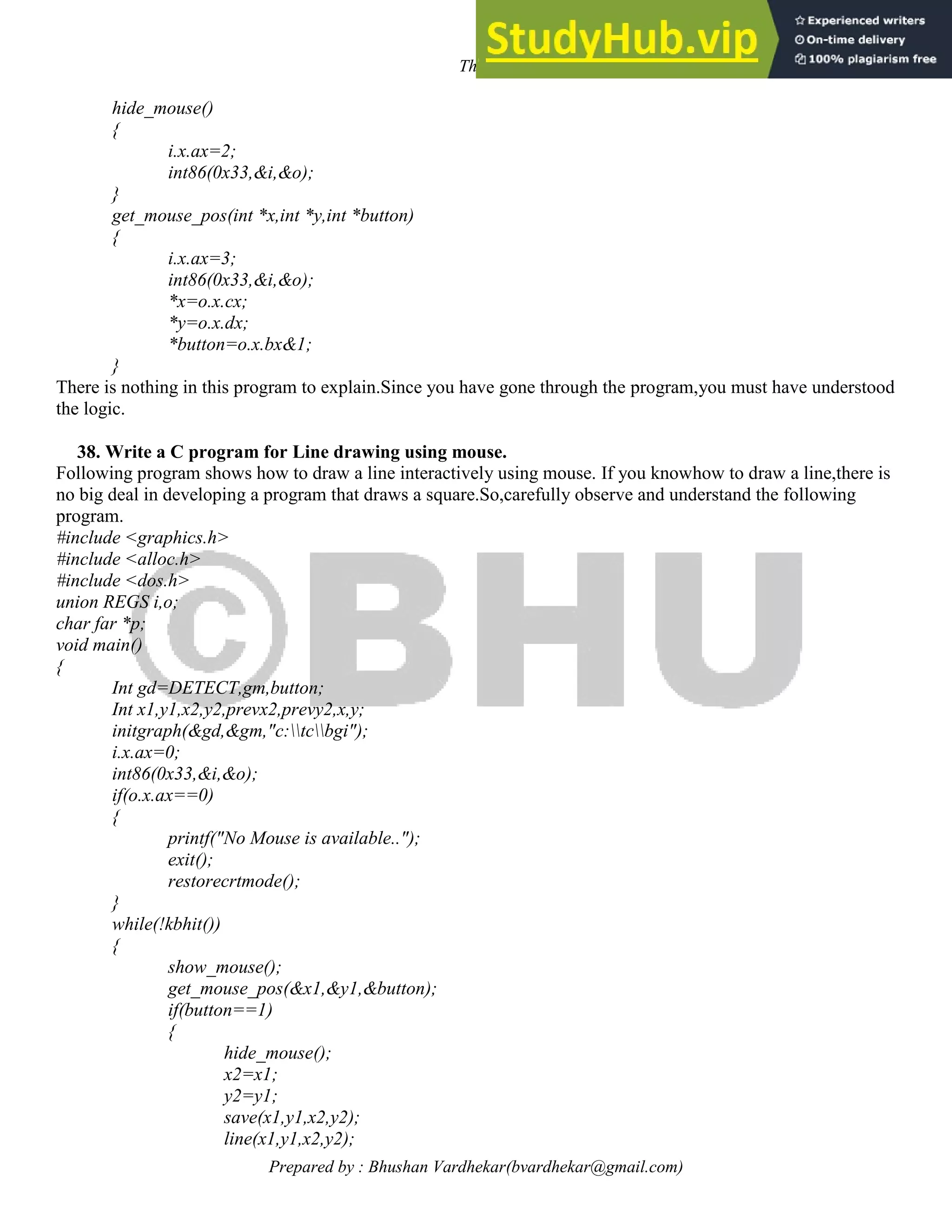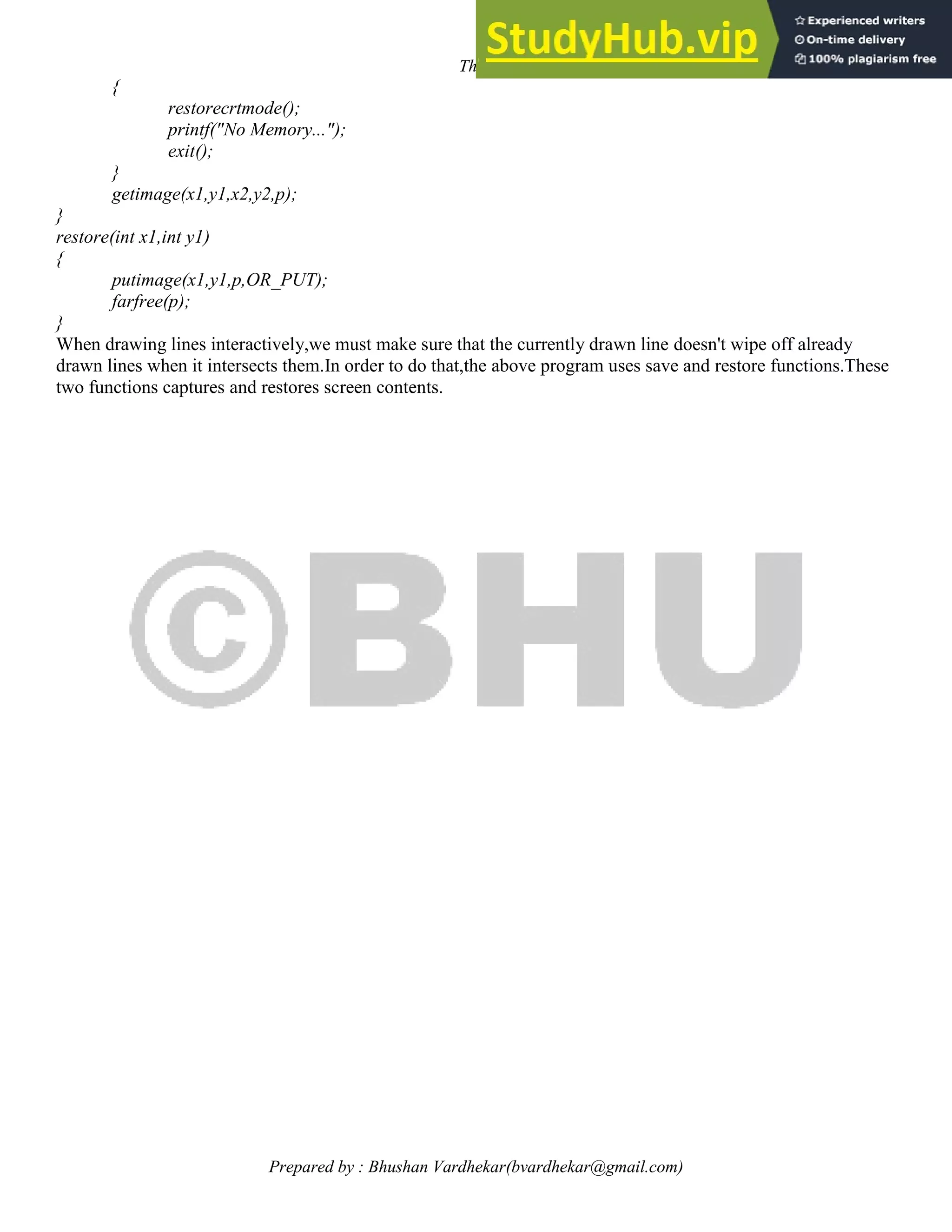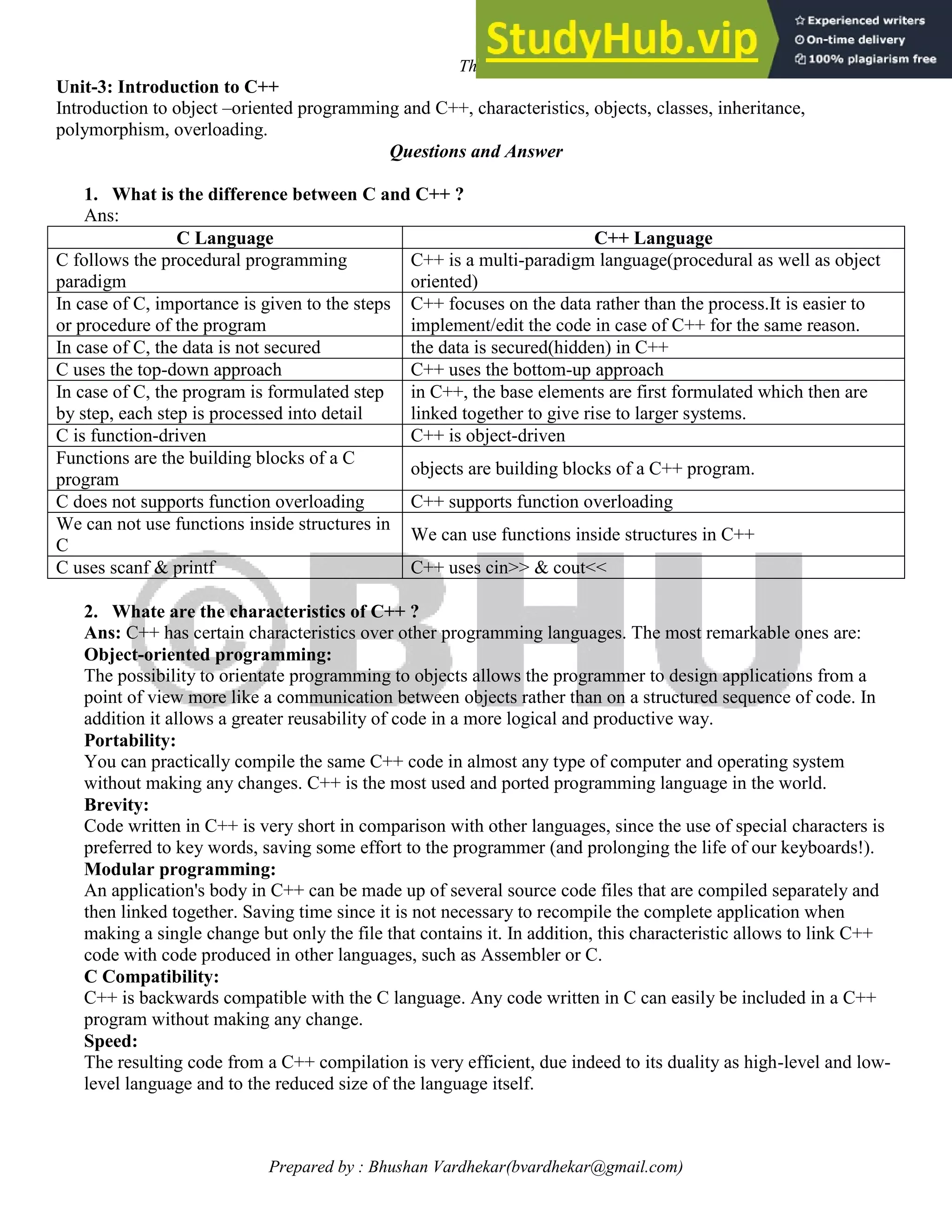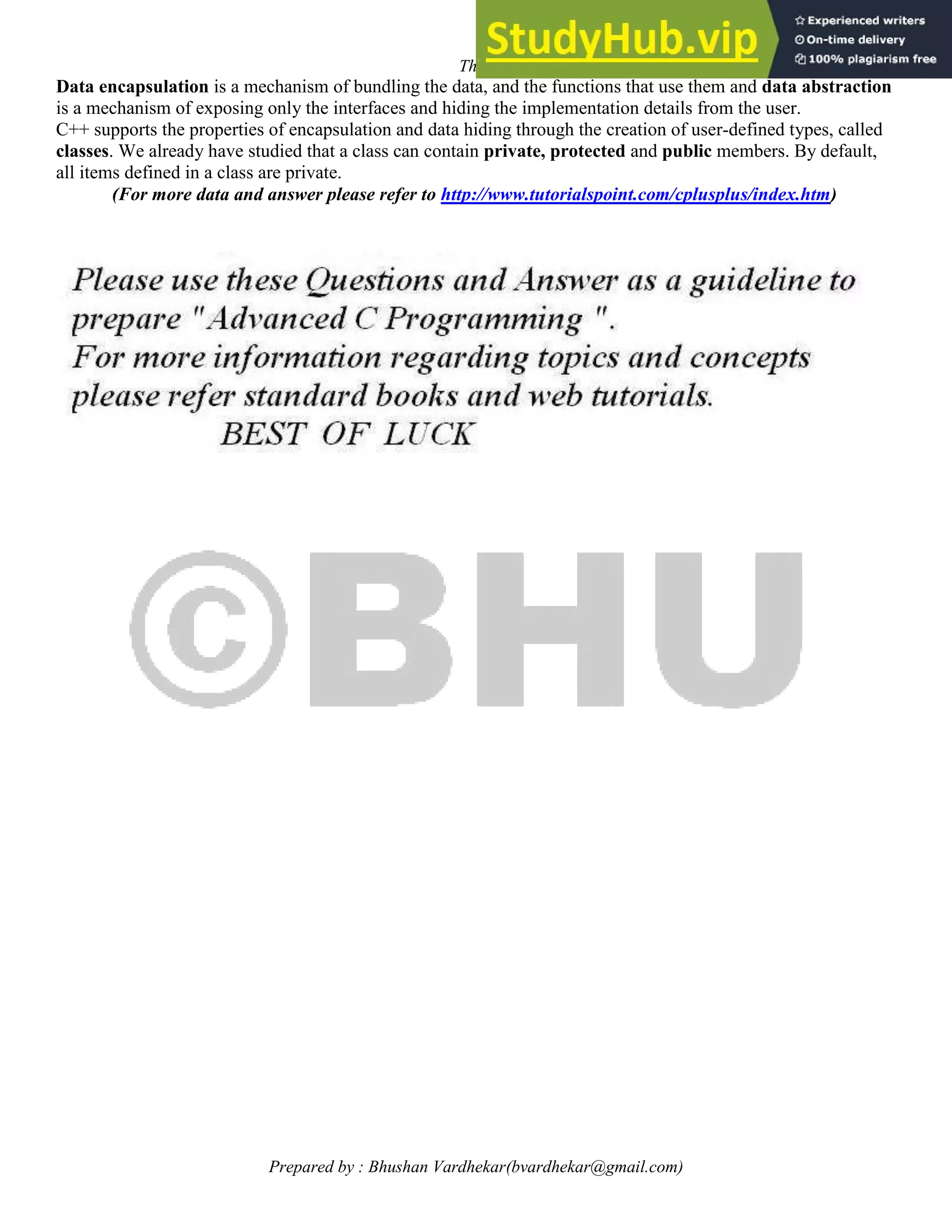These notes summarize key concepts from an advanced C programming document:
1. The document covers fundamental C programming concepts such as data types, operators, control statements, arrays, pointers, functions, structures, unions, and enumeration.
2. Questions and answers are provided to explain concepts like variable declaration vs definition, static vs automatic variables, register variables, structure vs union, and differences between 'break' and 'continue'.
3. Bitwise operators and shifts are discussed alongside examples to check specific bits, turn bits off, and demonstrate multiplying by 2 using left shifts.
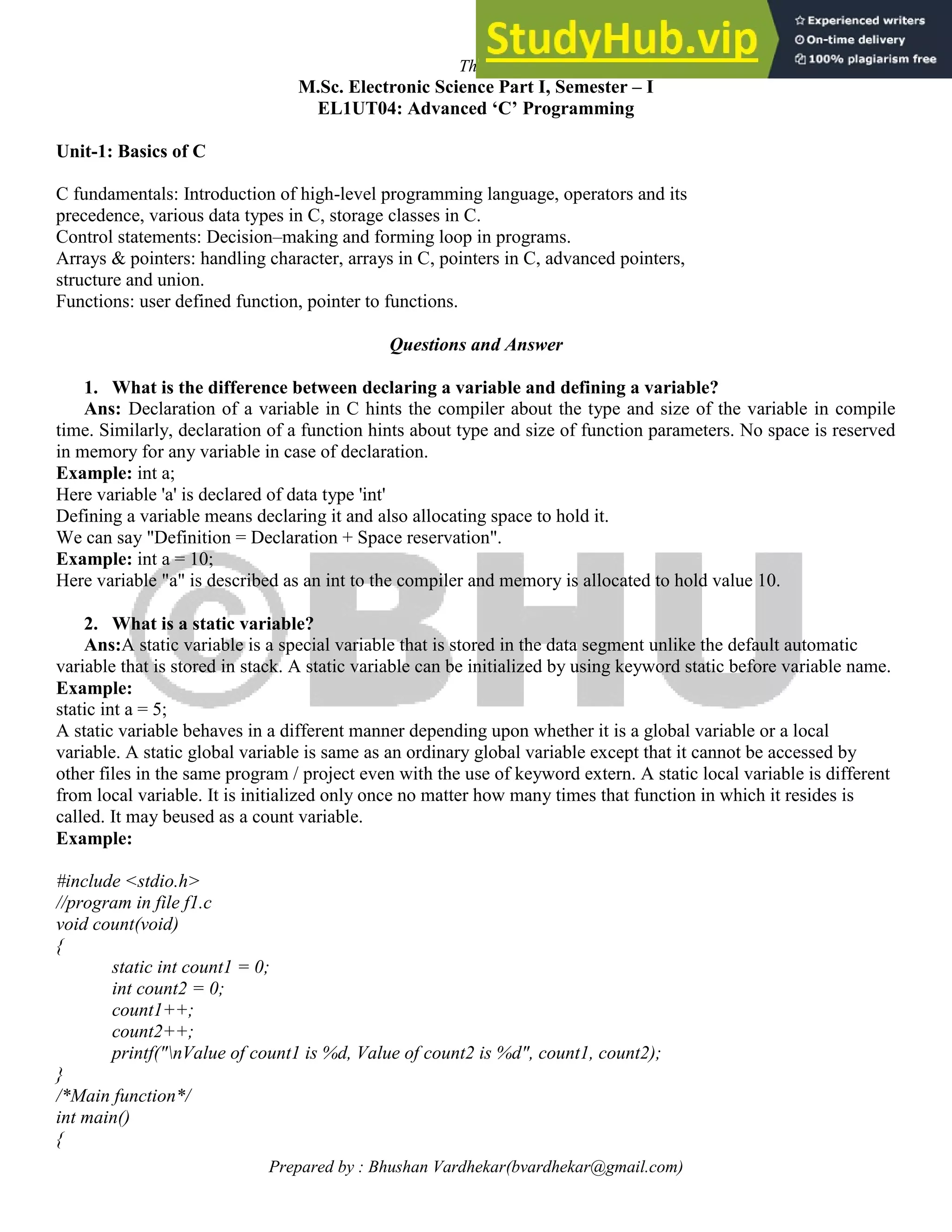


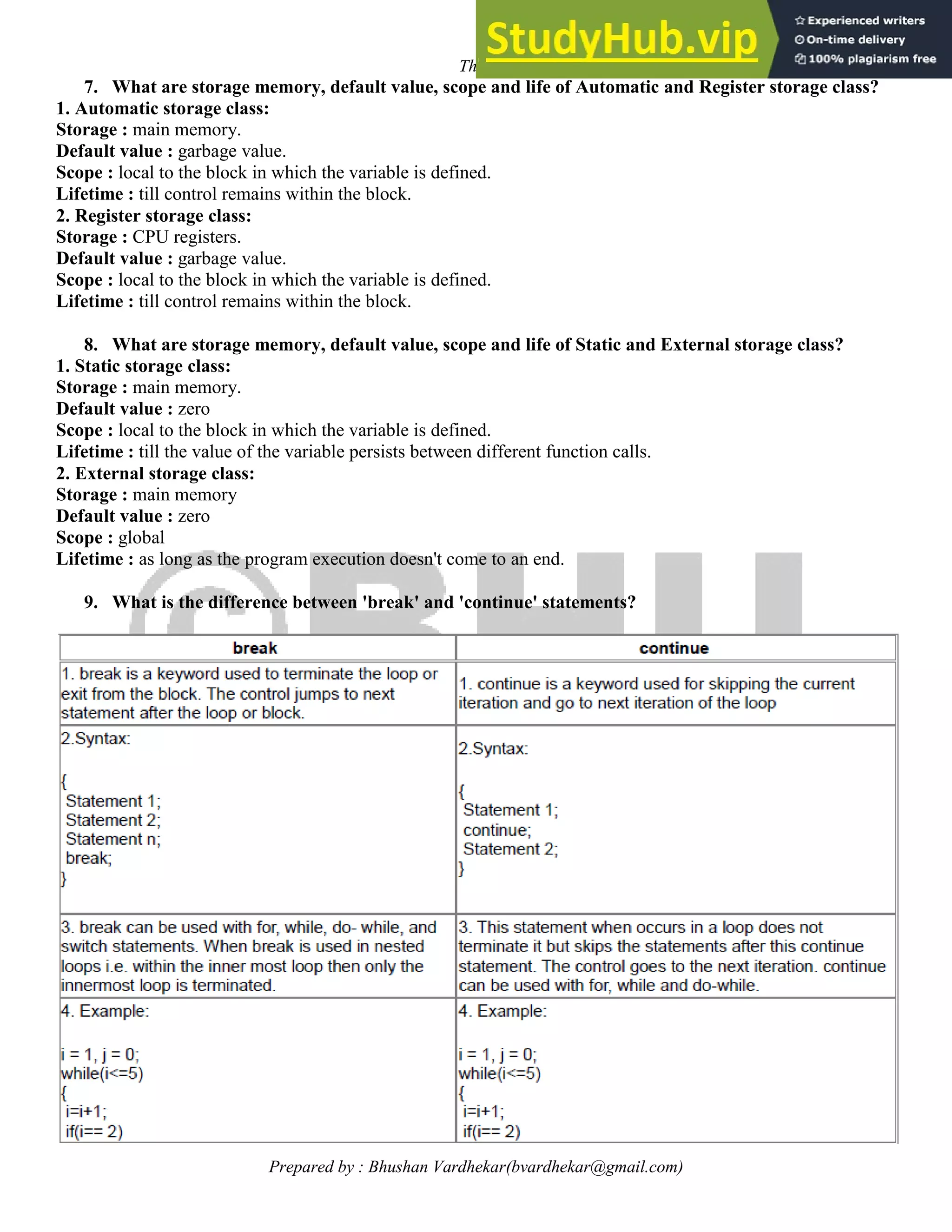
![These notes are prepared according to Pune university syllabus
Prepared by : Bhushan Vardhekar(bvardhekar@gmail.com)
10. What is the difference between 'for' and 'while' loops?
for loop: When it is desired to do initialization, condition check and increment/decrement in a single statement
of an iterative loop, it is recommended to use 'for' loop.
Syntax: for(initialization;condition;increment/decrement)
{
//block of statements increment or decrement
}
Program: Program to illustrate for loop
#include<stdio.h>
int main()
{
int i;
for (i = 1; i <= 5; i++)
{
//print the number
printf("n %d", i);
}
return 0;
}
Output:
12345
Explanation:
The loop repeats for 5 times and prints value of 'i' each time. 'i' increases by 1 for every cycle of loop.
while loop: When it is not necessary to do initialization, condition check and increment/decrement in a single
statement of an iterative loop, while loop could be used. In while loop statement, only condition statement is
present.
Syntax:
#include<stdio.h>
int main()
{
int i = 0, flag = 0;
int a[10] = { 0, 1, 4, 6, 89, 54, 78, 25, 635, 500 };
//This loop is repeated until the condition is false.
while (flag == 0)
{
if (a[i] == 54)
{
//as element is found, flag = 1,the loop terminates
flag = 1;
}
else
{
i++;
}
}
printf("Element found at %d th location", i);
return 0;
}](https://image.slidesharecdn.com/advancedcprogrammingnotes-230806153940-22109339/75/Advanced-C-Programming-Notes-5-2048.jpg)
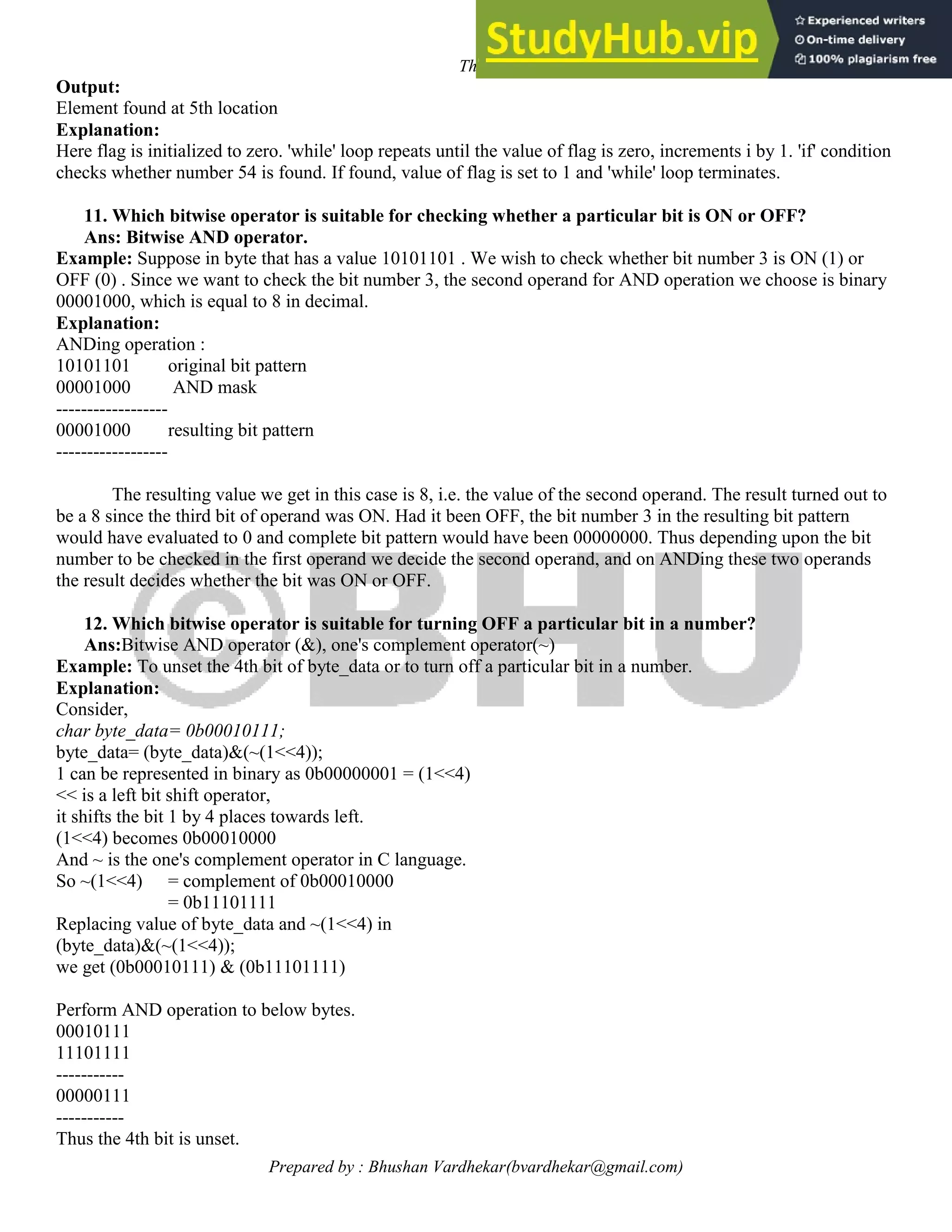
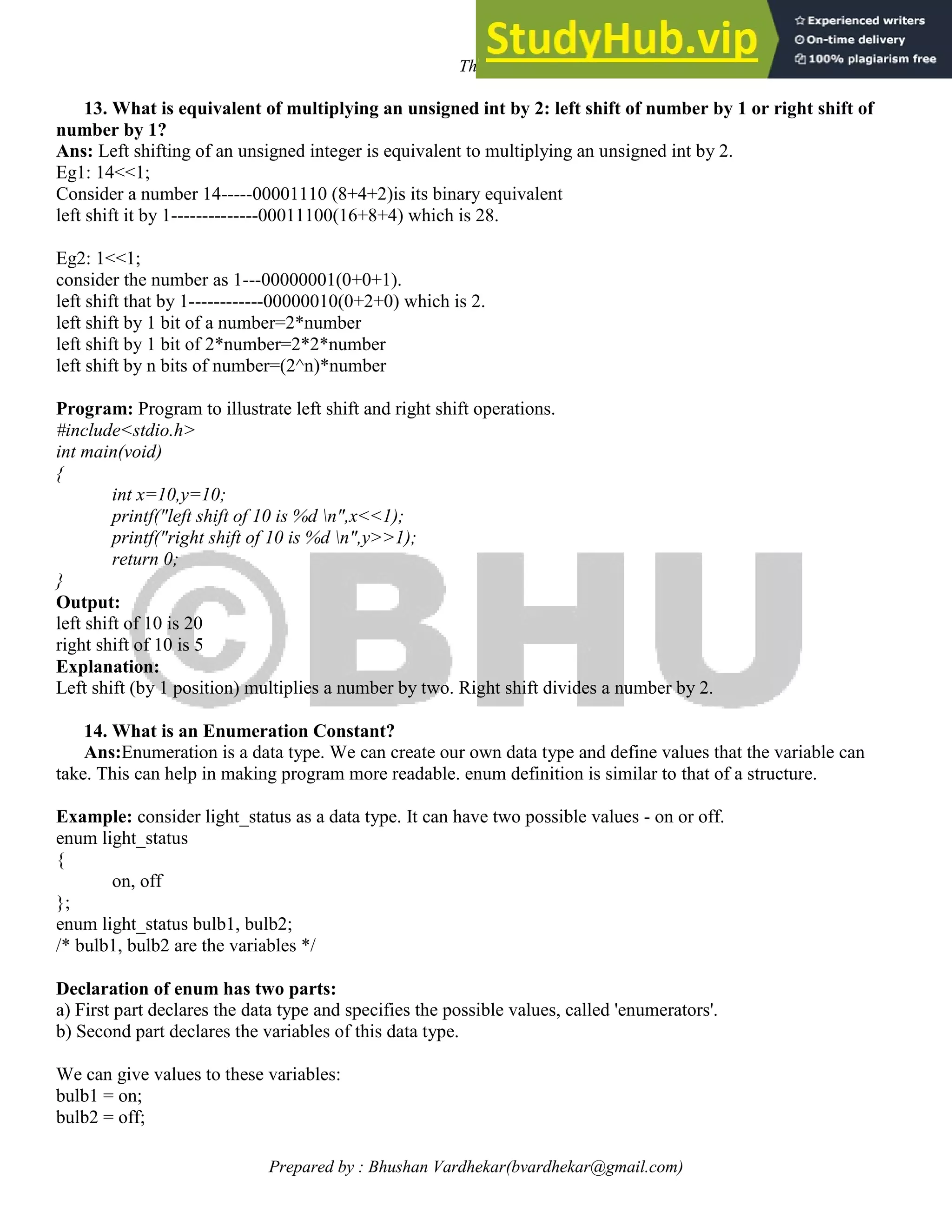
![These notes are prepared according to Pune university syllabus
Prepared by : Bhushan Vardhekar(bvardhekar@gmail.com)
15. What is a structure?
Ans:A structure is a collection of pre-defined data types to create a user-defined data type. Let us say we need
to create records of students. Each student has three fields:
int roll_number;
char name[30];
int total_marks;
This concept would be particularly useful in grouping data types. You could declare a structure student as:
struct student
{
int roll_number;
char name[30];
int total_marks;
} student1, student2;
The above snippet of code would declare a structure by name student and it initializes two objects student1,
student2. Now these objects and their fields could be accessed by saying student1.roll_number for accesing roll
number field of student1 object, similarly student2.name for accesing name field of student2 object.
16. What are the advantages of unions?
Ans: Union is a collection of data items of different data types. It can hold data of only one member at a
time though it has members of different data types. If a union has two members of different data types, they are
allocated the same memory. The memory allocated is equal to maximum size of the members. The data is
interpreted in bytes depending on which member is being accessed.
Example:
union pen
{
char name;
float point;
};
Here name and point are union members. Out of these two variables, 'point' is larger variable which is of float
data type and it would need 4 bytes of memory. Therefore 4 bytes space is allocated for both the variables. Both
the variables have the same memory location. They are accessed according to their type. Union is efficient
when members of it are not required to be accessed at the same time.
17. What are the differences between a structure and a union?
Ans: Structures and Unions are used to store members of different data types.
STRUCTURE UNION
a)Declaration:
struct
{
data type member1;
data type member2;
};
a)Declaration:
union
{
data type member1;
data type member2;
};
b) Every structure member is allocated memory when
a structure variable is defined.
b)The memory equivalent to the largest item is
allocated commonly for all members.](https://image.slidesharecdn.com/advancedcprogrammingnotes-230806153940-22109339/75/Advanced-C-Programming-Notes-8-2048.jpg)
![These notes are prepared according to Pune university syllabus
Prepared by : Bhushan Vardhekar(bvardhekar@gmail.com)
Example:
struct emp
{
char name[5];
int age;
float sal;
};
struct emp e1;
Memory allocated for structure is 1+2+4=7 bytes. 1
byte for name, 2 bytes for age and 4 bytes for sal.
Example:
union emp1
{
char name[5];
int age;
float sal;
};
union emp1 e2;
Memory allocated to a union is equal to size of the
largest member. In this case, float is the largest-sized
data type. Hence memory allocated to this union is 4
bytes.
c)All structure variables can be initialized at a time
struct st
{
int a;
float b;
};
struct st s = { .a=4, .b=10.5 };
Structure is used when all members are to be
independently used in a program.
c)Only one union member can be initialized at a time
union un
{
int a;
float b;
};
union un un1 = { .a=10 };
Union is used when members of it are not required to
be accessed at the same time.
18. How can typedef be to define a type of structure?
Ans: typedef declaration helps to make source code of a C program more readable. Its purpose is to redefine
the name of an existing variable type. It provides a short and meaningful way to call a data type. typedef is
useful when the name of the data type is long. Use of typedef can reduce length and complexity of data types.
Note: Usually uppercase letters are used to make it clear that we are dealing with our own data type.
Example:
struct employee
{
char name[20];
int age;
};
struct employee e;
The above declaration of the structure would be easy to use when renamed using typedef as:
struct employee
{
char name[20];
int age;
};
typedef struct employee EMP;
EMP e1, e2;
19. Write a program that returns 3 numbers from a function using a structure.
Ans: A function in C can return only one value. If we want the function to return multiple values, we need
to create a structure variable, which has three integer members and return this structure.](https://image.slidesharecdn.com/advancedcprogrammingnotes-230806153940-22109339/75/Advanced-C-Programming-Notes-9-2048.jpg)
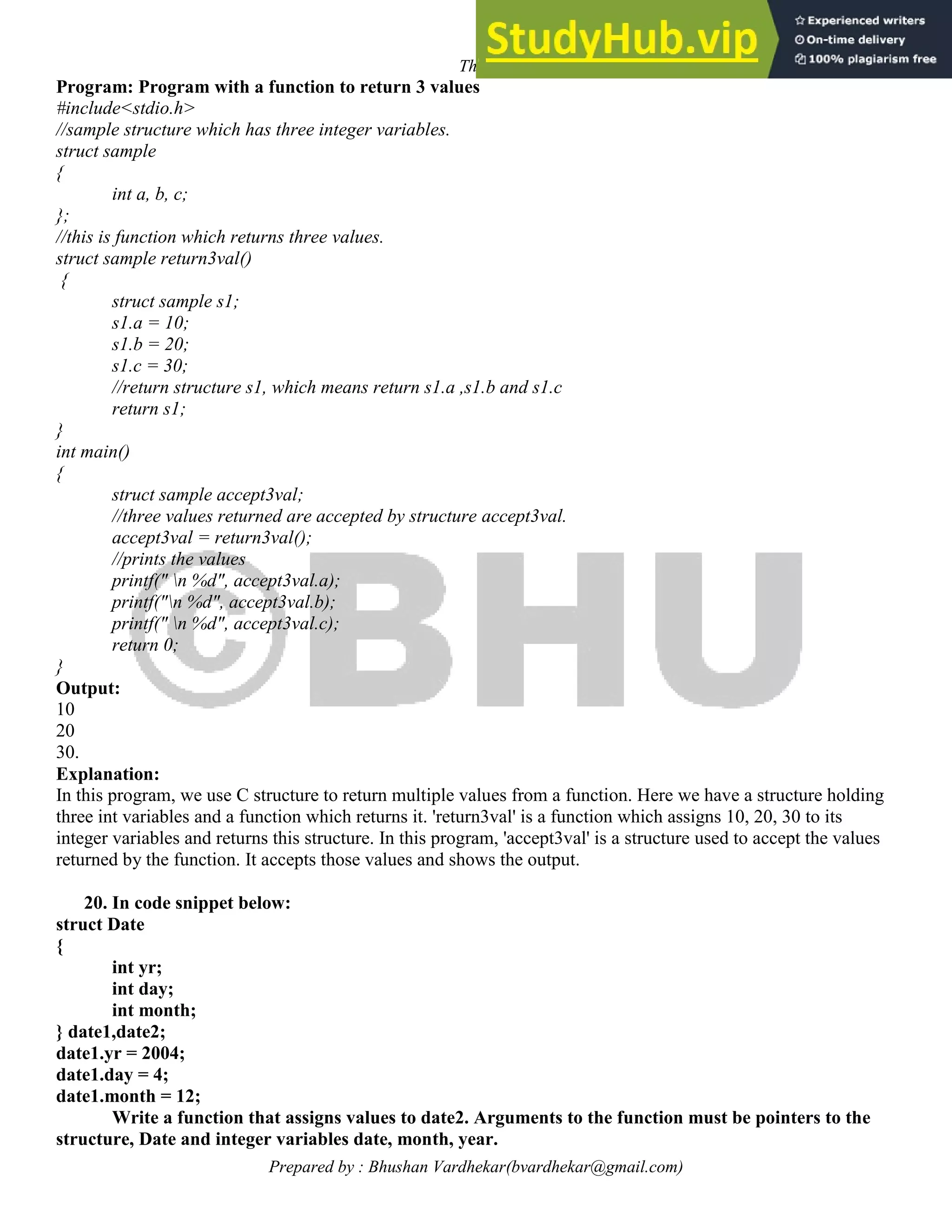
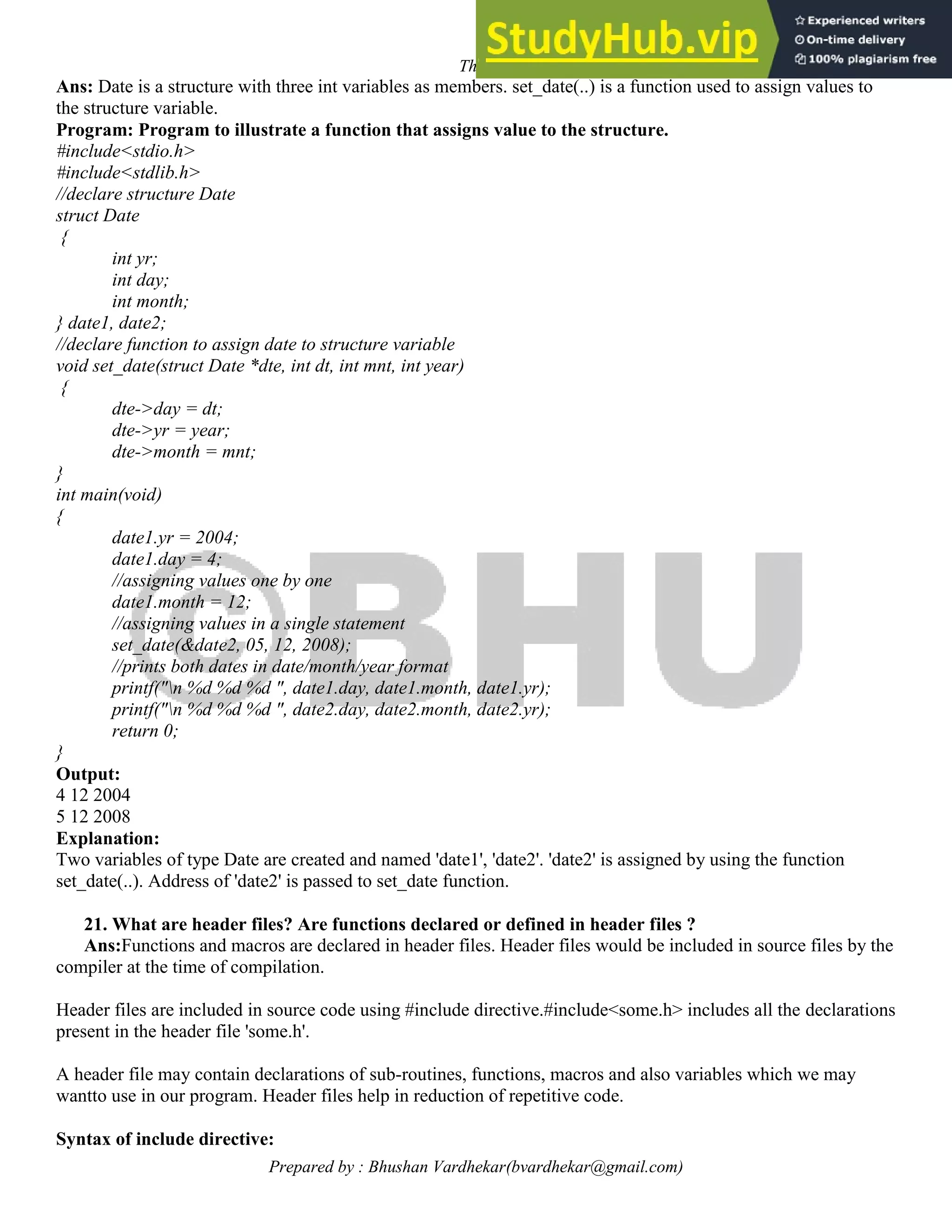
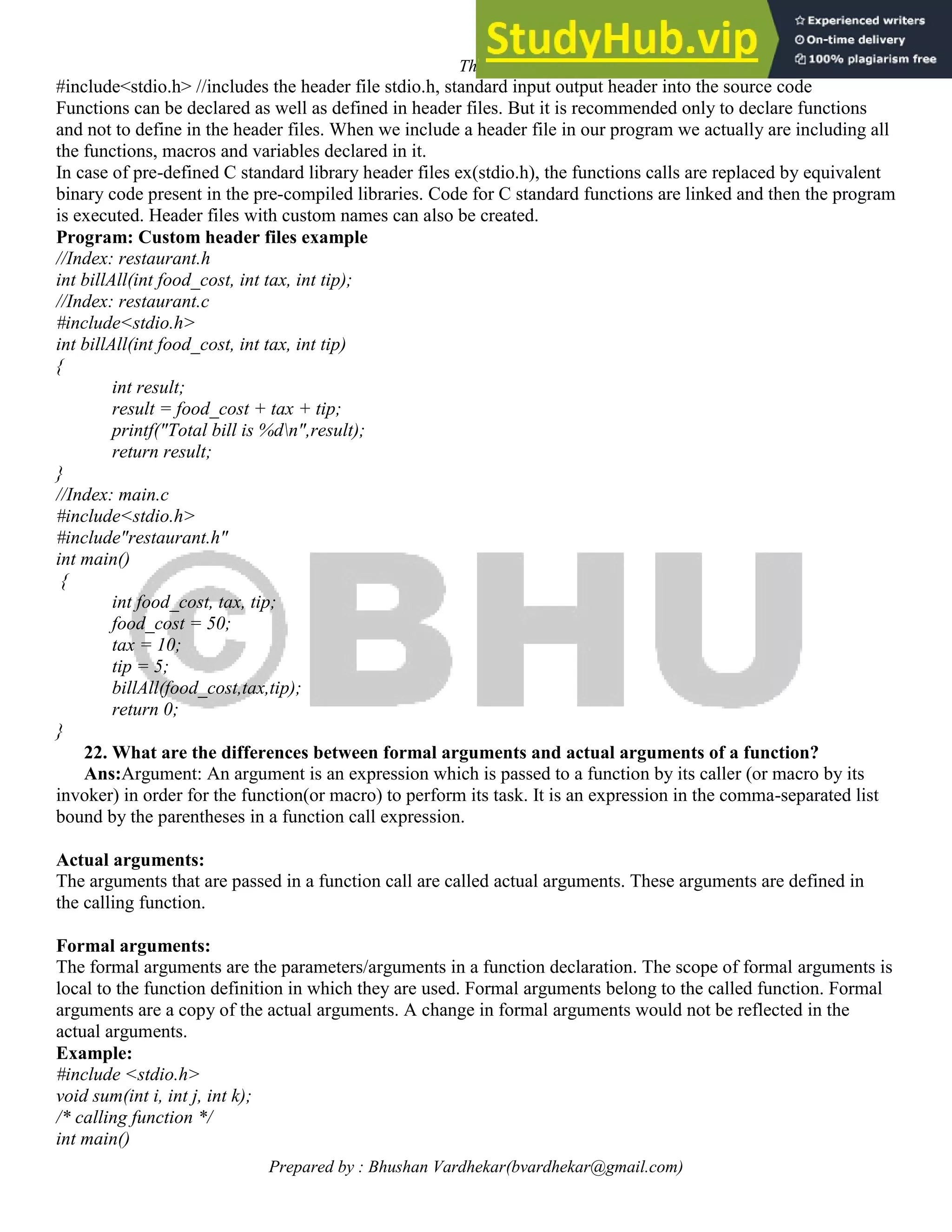
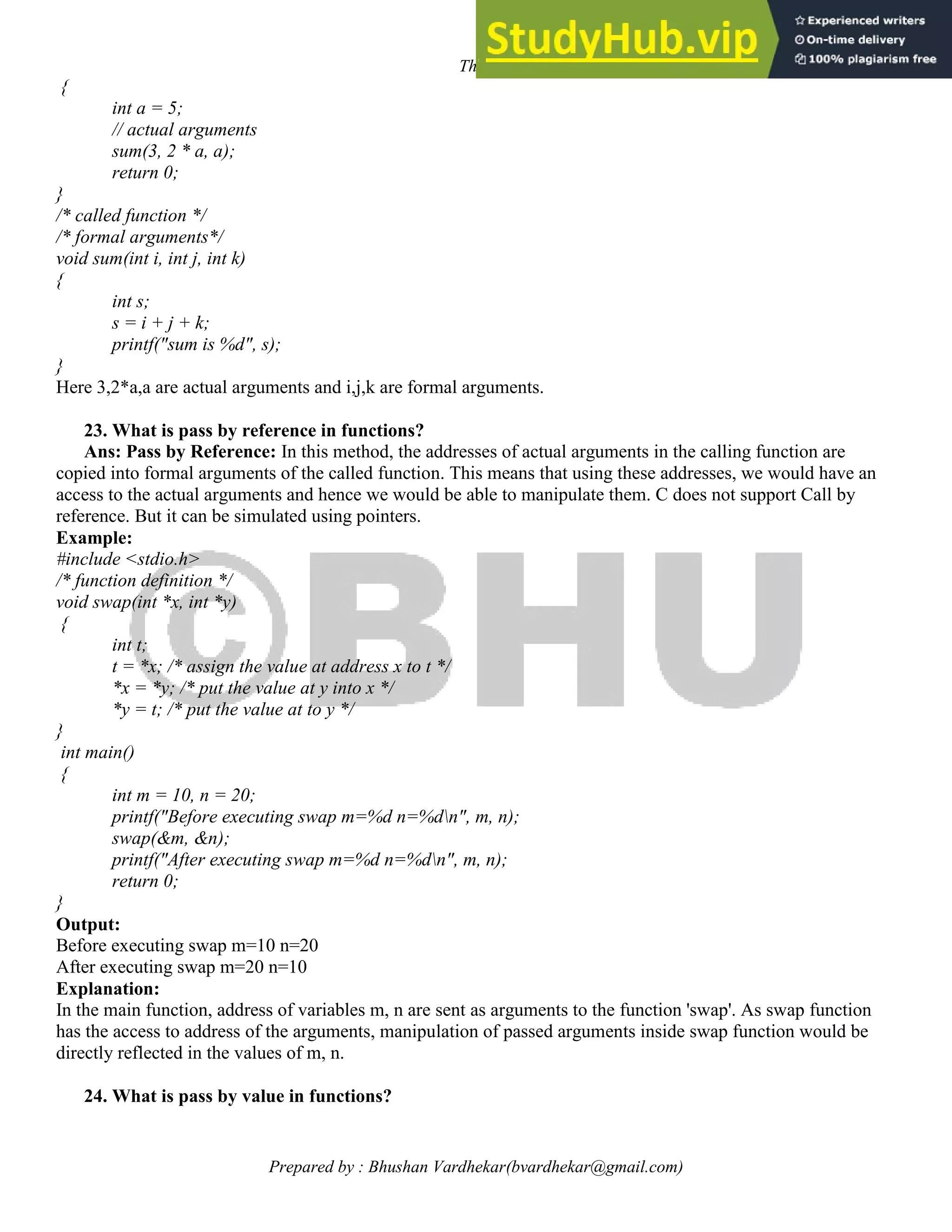
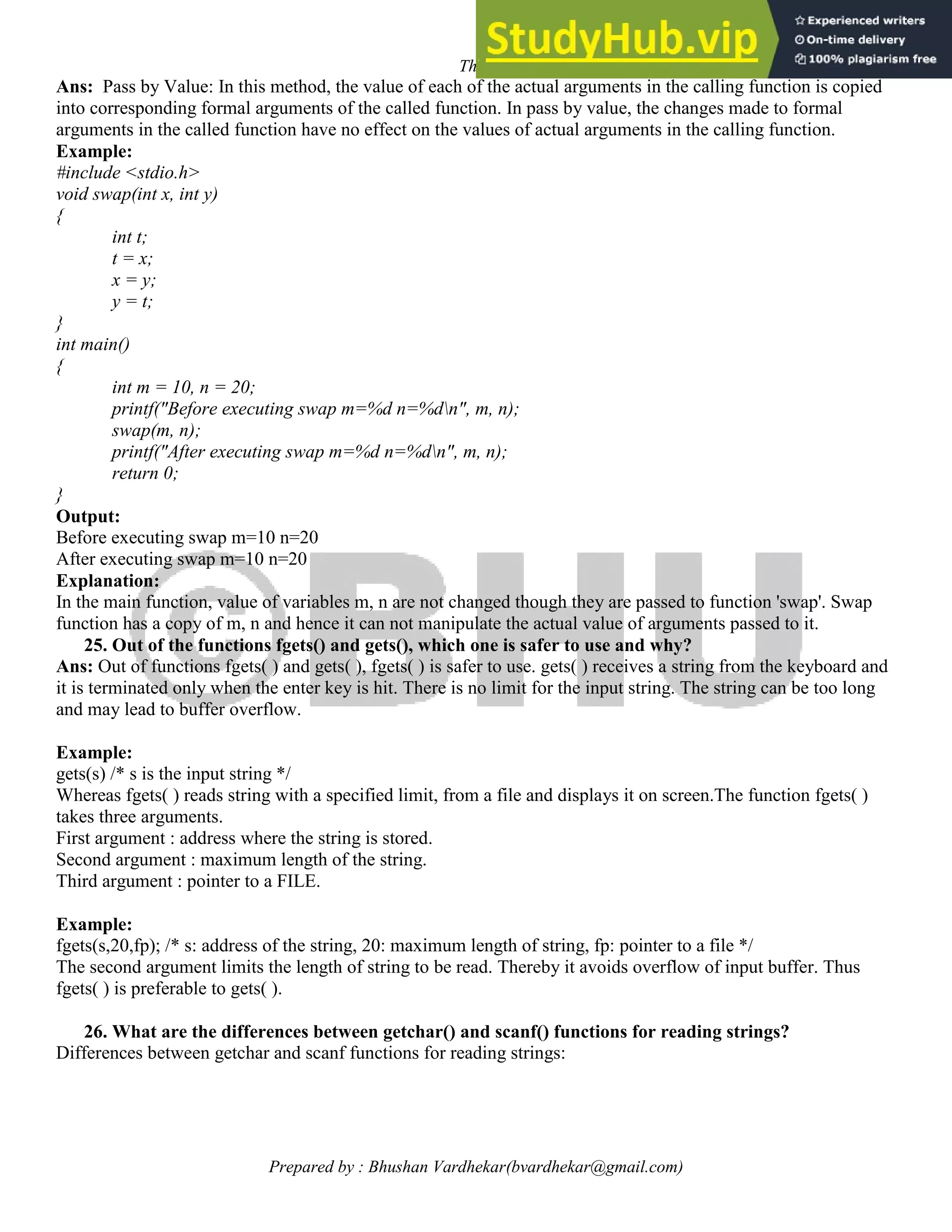
![These notes are prepared according to Pune university syllabus
Prepared by : Bhushan Vardhekar(bvardhekar@gmail.com)
27. What is the difference between the functions strdup() and strcpy()?
Ans: strcpy function: copies a source string to a destination defined by user. In strcpy function both source
and destination strings are passed as arguments. User should make sure that destination has enough space to
accommodate the string to be copied. 'strcpy' sounds like short form of "string copy".
Syntax:
strcpy(char *destination, const char *source);
Source string is the string to be copied and destination string is string into which source string is copied. If
successful, strcpy subroutine returns the address of the copied string. Otherwise, a null pointer is returned.
Example Program:
#include<stdio.h>
#include<string.h>
int main()
{
char myname[10];
//copy contents to myname
strcpy(myname, "interviewmantra.net");
//print the string
puts(myname);
return 0;
}
Output:
interviewmantra.net
Explanation:](https://image.slidesharecdn.com/advancedcprogrammingnotes-230806153940-22109339/75/Advanced-C-Programming-Notes-15-2048.jpg)
![These notes are prepared according to Pune university syllabus
Prepared by : Bhushan Vardhekar(bvardhekar@gmail.com)
If the string to be copied has more than 10 letters, strcpy cannot copy this string into the string 'myname'. This is
because string 'myname' is declared to be of size 10 characters only.
In the above program, string "nodalo" is copied in myname and is printed on output screen.
strdup function: duplicates a string to a location that will be decided by the function itself. Function will copy
the contents of string to certain memory location and returns the address to that location. 'strdup' sounds like
short form of "string duplicate"
Syntax:
strdup (const char *s);
strdup returns a pointer to a character or base address of an array. Function returns address of the memory
location where the string has been copied. In case free space could not be created then it returns a null pointer.
Both strcpy and strdup functions are present in header file <string.h>
Program: Program to illustrate strdup().
#include<stdio.h>
#include<string.h>
#include<stdlib.h>
int main()
{
char myname[] = "interviewmantra.net";
//name is pointer variable which can store the address of memory location of string
char* name;
//contents of myname are copied in a memory address and are assigned to name
name = strdup(myname);
//prints the contents of 'name'
puts(name);
//prints the contents of 'myname'
puts(myname);
//memory allocated to 'name' is now freed
free(name);
return 0;
}
Output:
interviewmantra.net
interviewmantra.net
Explanation:
String myname consists of "interviewmantra.net" stored in it. Contents of myname are copied in a memory
address and memory is assigned to name. At the end of the program, memory can be freed using free(name);
28. What is a pointer in C?
A pointer is a special variable in C language meant just to store address of any other variable or function.
Pointer variables unlike ordinary variables cannot be operated with all the arithmetic operations such as '*','%'
operators. It follows a special arithmetic called as pointer arithmetic.
A pointer is declared as:
int *ap;
int a = 5;
In the above two statements an integer a was declared and initialized to 5. A pointer to an integer with name ap
was declared.
Next before ap is used
ap=&a;
This operation would initialize the declared pointer to int. The pointer ap is now said to point to a.](https://image.slidesharecdn.com/advancedcprogrammingnotes-230806153940-22109339/75/Advanced-C-Programming-Notes-16-2048.jpg)
![These notes are prepared according to Pune university syllabus
Prepared by : Bhushan Vardhekar(bvardhekar@gmail.com)
Operations on a pointer:
Dereferencing operator ' * ': This operator gives the value at the address pointed by the pointer . For
example after the above C statements if we give
printf("%d",*ap);
Actual value of a that is 5 would be printed. That is because ap points to a.
Addition operator ' + ': Pointer arithmetic is different from ordinary arithmetic.
ap=ap+1;
Above expression would not increment the value of ap by one, but would increment it by the number of
bytes of the data type it is pointing to. Here ap is pointing to an integer variable hence ap is incremented
by 2 or 4 bytes depending upon the compiler.
29. What are the advantages of using pointers?
Ans: Pointers are special variables which store address of some other variables.
Syntax: datatype *ptr;
Here * indicates that ptr is a pointer variable which represents value stored at a particular address.
Example: int *p;
'p' is a pointer variable pointing to address location where an integer type is stored.
Advantages:
1. Pointers allow us to pass values to functions using call by reference. This is useful when large sized
arrays are passed as arguments to functions. A function can return more than one value by using call by
reference.
2. Dynamic allocation of memory is possible with the help of pointers.
3. We can resize data structures. For instance, if an array's memory is fixed, it cannot be resized. But in
case of an array whose memory is created out of malloc can be resized.
4. Pointers point to physical memory and allow quicker access to data.
30. What is the equivalent pointer expression for referring an element a[i][j][k][l], in a four
dimensional array?
Ans: Consider a multidimensional array a[w][x][y][z].
In this array, a[i] gives address of a[i][0][0][0] and a[i]+j gives the address of a[i][j][0][0]
Similarly, a[i][j] gives address of a[i][j][0][0] and a[i][j]+k gives the address of a[i][j][k][0]
a[i][j][k] gives address of a[i][j][k][0] and a[i][j][k]+l gives address of a[i][j][k][l]
Hence a[i][j][k][l] can be accessed using pointers as *(a[i][j][k]+l)
where * stands for value at address and a[i][j][k]+l gives the address location of a[i][j][k][l].
Program: Example program to illustrate pointer denotation of multi-dimensional arrays.
#include<stdio.h>
#include<string.h>
int main()
{
int a[3][3][3][3];
//it gives address of a[0][0][0][0] .
printf(" n address of array a is %u", a);
printf("n address of a[2][0][0][0] is %u ,given by a[2], %u given by a+2",
a[2], a + 2);
printf("n address of a[2][2][0][0] is %u ,given by a[2][2], %u given by a[2]+2",
a[2][2], a[2] + 2);
printf("n address of a[2][2][1][0] is %u ,given by a[2][2][1] , %u given by a[2][2]+1",](https://image.slidesharecdn.com/advancedcprogrammingnotes-230806153940-22109339/75/Advanced-C-Programming-Notes-17-2048.jpg)
![These notes are prepared according to Pune university syllabus
Prepared by : Bhushan Vardhekar(bvardhekar@gmail.com)
a[2][2][1], a[2][2] + 1);
return 0;
}
Output:
address of array a is 65340
address of a[2][0][0][0] is 65448, given by a[2] , 65448 given by a+2
address of a[2][2][0][0] is 65484, given by a[2][2] ,65484 given by a[2]+2
address of a[2][2][1][0] is 65490, given by a[2][2][1] , 65490 given by a[2][2]+1
Explanation:
This output may differ from computer to computer as the address locations are not same for every computer.
31. Declare an array of three function pointers where each function receives two integers and
returns float.
Declaration: float (*fn[3])(int, int);
Program: Illustrates the usage of above declaration
#include<stdio.h>
float (*fn[3])(int, int);
float add(int, int);
int main()
{
int x, y, z, j;
for (j = 0; j < 3; j++)
{
fn[j] = &add;
}
x = fn[0](10, 20);
y = fn[1](100, 200);
z = fn[2](1000, 2000);
printf("sum1 is: %d n", x);
printf("sum2 is: %d n", y);
printf("sum3 is: %d n", z);
return 0;
}
float add(int x, int y)
{
float f = x + y;
return f;
}
Output:
sum1 is: 30
sum2 is: 300
sum3 is: 3000
Explanation:
Here 'fn[3]' is an array of function pointers. Each element of the array can store the address of function 'float
add(int, int)'.
fn[0]=fn[1]=fn[2]=&add
Wherever this address is encountered add(int, int) function is called.
32. Explain the variable assignment in the declaration
Ans: int *(*p[10])(char *, char *);](https://image.slidesharecdn.com/advancedcprogrammingnotes-230806153940-22109339/75/Advanced-C-Programming-Notes-18-2048.jpg)
![These notes are prepared according to Pune university syllabus
Prepared by : Bhushan Vardhekar(bvardhekar@gmail.com)
It is an array of function pointers that returns an integer pointer. Each function has two arguments which in
turn are pointers to character type variable. p[0], p[1],....., p[9] are function pointers.
return type : integer pointer.
p[10] : array of function pointers
char * : arguments passed to the function
Program: Example program to explain function pointers.
#include<stdio.h>
#include<stdlib.h>
int *(*p[10])(char *, char *);
/*average function which returns pointer to integer whose value is average of ascii value of characters passed
by pointers*/
int *average(char *, char *);
//function which returns pointer to integer whose value is sum of ascii value of characters passed by pointers
int *sum(char *, char *);
int retrn;
int main(void)
{
int i;
for (i = 0; i < 5; i++)
{
//p[0] to p[4] are pointers to average function.
p[i] = &(average);
}
for (i = 5; i < 10; i++)
{
//p[5] to p[9] are pointers to sum function
p[i] = &(sum);
}
char str[10] = "nodalo.com";
int *intstr[10];
for (i = 0; i < 9; i++)
{
//upto p[4] average function is called, from p[5] sum is called.
intstr[i] = p[i](&str[i], &str[i + 1]);
if (i < 5)
{
//prints the average of ascii of both characters
printf(" n average of %c and %c is %d",
str[i], str[i + 1],*intstr[i]);
}
else
{
//prints the sum of ascii of both characters.
printf(" n sum of %c and %c is %d",
str[i], str[i + 1], *intstr[i]);
}
}
return 0;
}](https://image.slidesharecdn.com/advancedcprogrammingnotes-230806153940-22109339/75/Advanced-C-Programming-Notes-19-2048.jpg)
![These notes are prepared according to Pune university syllabus
Prepared by : Bhushan Vardhekar(bvardhekar@gmail.com)
//function average is defined here
int *average(char *arg1, char *arg2)
{
retrn = (*arg1 + *arg2) / 2;
return (&retrn);
}
//function sum is defined here
int *sum(char *arg1, char *arg2)
{
retrn = (*arg1 + *arg2);
return (&retrn);
}
Output:
average of n and o is 110
average of o and d is 105
average of d and a is 98 average of d and a is 98
average of a and l is 102
average of l and o is 109
sum of o and . is 157
sum of . and c is 145
sum of c and o is 210
sum of o and m is 220
Explanation:
In this program p[10] is an array of function pointers. First five elements of p[10] point to the function: int
*average(char *arg1,char *arg2). Next five elements point to the function int *sum(char *arg1,char *arg2).
They
return pointer to an integer and accept pointer to char as arguments.
Function average:
int *average(char *arg1,char *arg2) This function finds the average of the two values of the addresses passed to
it as arguments and returns address of the average value as an integer pointer.
Function sum:
int *sum(char *arg1,char *arg2) This function finds the sum of the two values of the addresses passed to it as
arguments and returns address of the sum value as an integer pointer.
33. What is the value of sizeof(a) /sizeof(char *)
in a code snippet:
char *a[4]={"sridhar","raghava","shashi","srikanth"};
Explanation:
Here a[4] is an array which holds the address of strings. Strings are character arrays themselves.
Memory required to store an address is 4 bits. So memory required to store 4 addresses is equal to 4*4=16 bits.
char *; is a pointer variable which stores the address of a char variable.
So sizeof(char *) is 4 bits. Therefore sizeof(a) /sizeof(char *) = 16/4 = 4 bytes.
34. (i) What are the differences between the C statements below:
char *str = "Hello";
char arr[] = "Hello";
(ii) Whether following statements get complied or not? Explain each statement.
arr++;
*(arr + 1) = 's';
printf("%s",arr);
Ans:](https://image.slidesharecdn.com/advancedcprogrammingnotes-230806153940-22109339/75/Advanced-C-Programming-Notes-20-2048.jpg)
![These notes are prepared according to Pune university syllabus
Prepared by : Bhushan Vardhekar(bvardhekar@gmail.com)
(i) char *str="Hello";
"Hello" is an anonymous string present in the memory. 'str' is a pointer variable that holds the address of
this string.
char arr[ ]="Hello";
This statement assigns space for six characters: 'H' 'e' 'l' 'l' 'o' '0' . 'arr' is the variable name assigned to this array
of characters.
str[4] and arr[4] also have different meanings.
str[4]: adds 4 to the value of 'str' and points to the address same as value of str + 4.
arr[4]: points to the fourth element in array named 'arr'.
(ii) 'arr' is variable name of an array. A variable name can not be incremented or decremented. Hence
arr++ is an invalid statement and would result in a compilation error.
*(arr+1)='s';
'arr' is the name of a character array that holds string "Hello". Usually, name of an array points to its base
address. Hence value of arr is same as &arr[0].
arr+1 is address of the next element: &arr[1]
Character 's' is assigned to the second element in array 'arr', thereby string changes from "Hello" to "Hsllo".
printf("%s",arr );
This statement prints the string stored in character array 'arr'.
35. Write a program to find factorial of the given number.
Ans: Recursion: A function is called 'recursive' if a statement within the body of a function calls the same
function. Itis also called 'circular definition'. Recursion is thus a process of defining something in terms of itself.
Program: To calculate the factorial value using recursion.
#include <stdio.h>
int fact(int n);
int main()
{
int x, i;
printf("Enter a value for x: n");
scanf("%d", &x);
i = fact(x);
printf("nFactorial of %d is %d", x, i);
return 0;
}
int fact(int n)
{
/* n=0 indicates a terminating condition */
if (n <= 0)
{
return (1);
}
else
{
/* function calling itself */
return (n * fact(n - 1));
/*n*fact(n-1) is a recursive expression */
}
}
Output:](https://image.slidesharecdn.com/advancedcprogrammingnotes-230806153940-22109339/75/Advanced-C-Programming-Notes-21-2048.jpg)
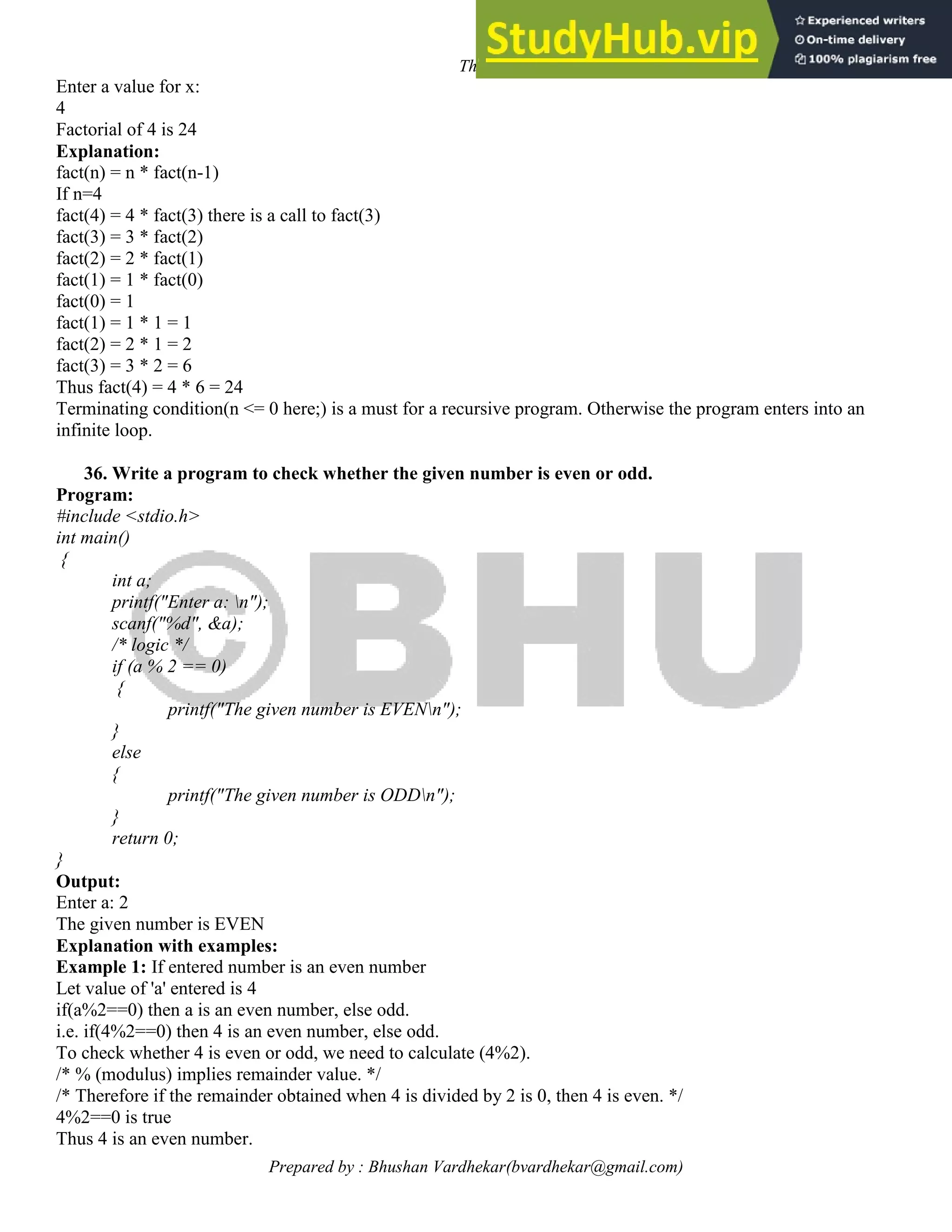
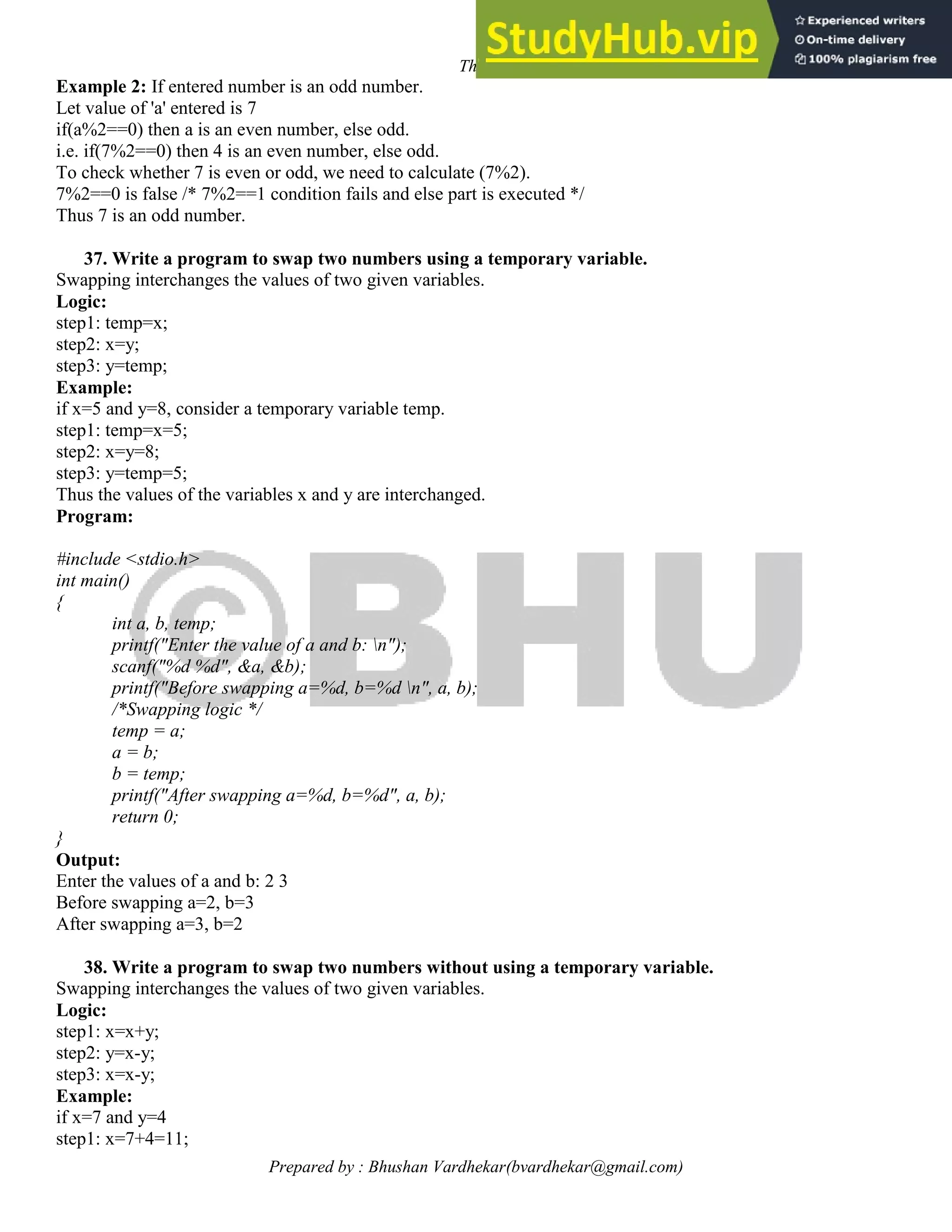
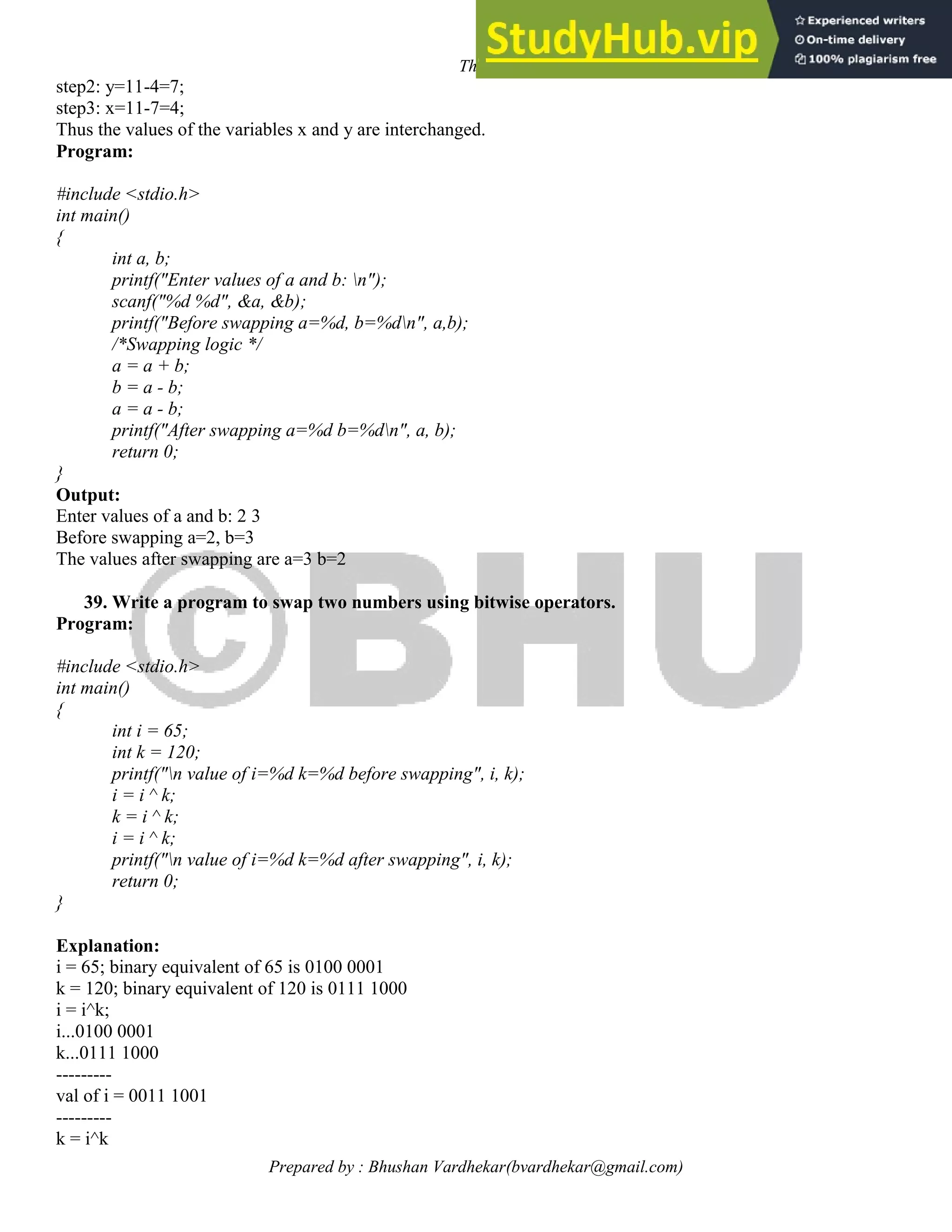
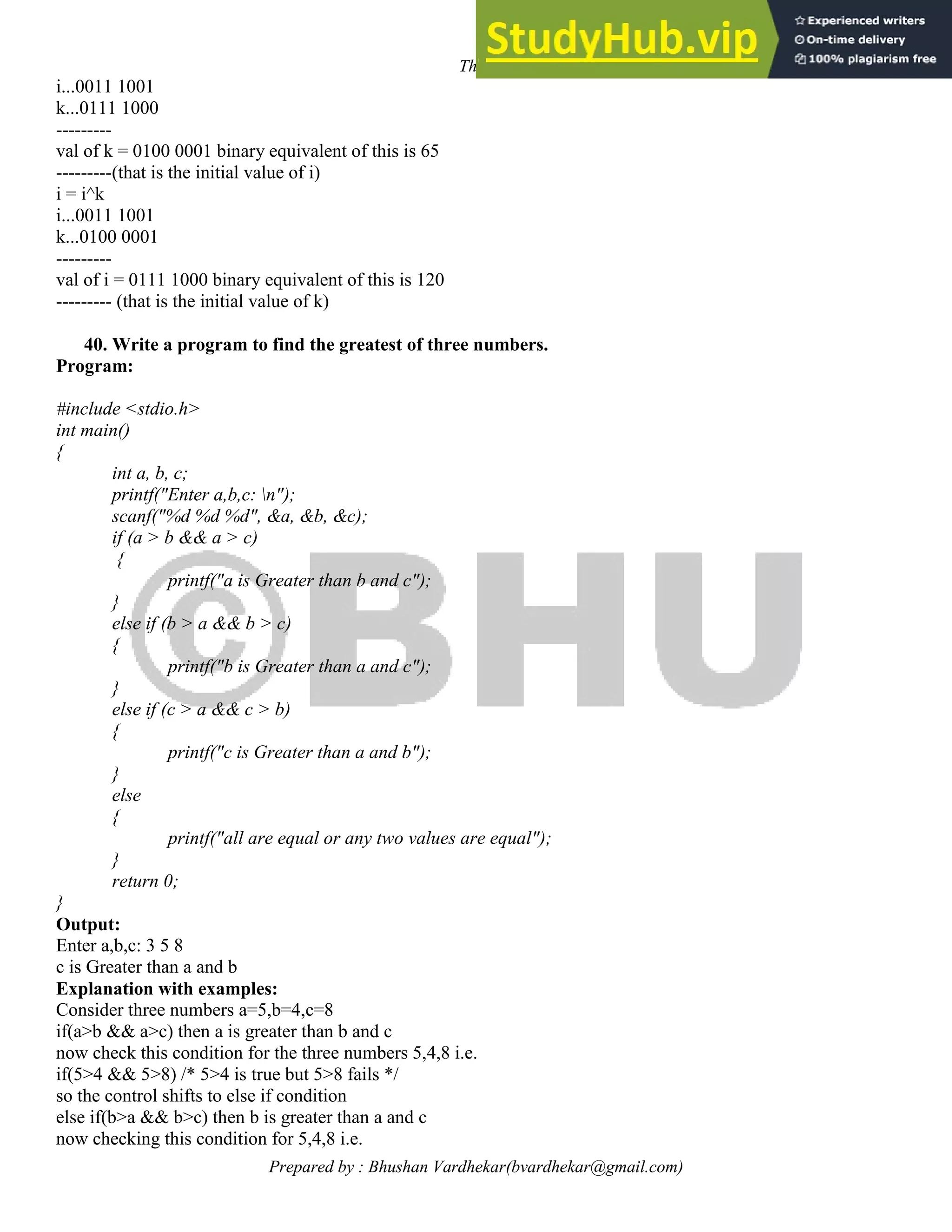
![These notes are prepared according to Pune university syllabus
Prepared by : Bhushan Vardhekar(bvardhekar@gmail.com)
else if(4>5 && 4>8) /* both the conditions fail */
now the control shifts to the next else if condition
else if(c>a && c>b) then c is greater than a and b
now checking this condition for 5,4,8 i.e.
else if(8>5 && 8>4) /* both conditions are satisfied */
Thus c is greater than a and b.
41. Write a program to find the greatest among ten numbers.
Program:
#include <stdio.h>
int main()
{
int a[10];
int i;
int greatest;
printf("Enter ten values:");
//Store 10 numbers in an array
for (i = 0; i < 10; i++)
{
scanf("%d", &a[i]);
}
//Assume that a[0] is greatest
greatest = a[0];
for (i = 0; i < 10; i++)
{
if (a[i] > greatest)
{
greatest = a[i];
}
}
printf("nGreatest of ten numbers is %d", greatest);
return 0;
}
Output:
Enter ten values: 2 53 65 3 88 8 14 5 77 64 Greatest of ten numbers is 88
Explanation with example:
Entered values are 2, 53, 65, 3, 88, 8, 14, 5, 77, 64
They are stored in an array of size 10. let a[] be an array holding these values.
/* how the greatest among ten numbers is found */
Let us consider a variable 'greatest'. At the beginning of the loop, variable 'greatest' is assinged with the value of
first element in the array greatest=a[0]. Here variable 'greatest' is assigned 2 as a[0]=2.
Below loop is executed until end of the array 'a[]';.
for(i=0; i<10; i++)
{
if(a[i]>greatest)
{
greatest= a[i];
}
}](https://image.slidesharecdn.com/advancedcprogrammingnotes-230806153940-22109339/75/Advanced-C-Programming-Notes-26-2048.jpg)
![These notes are prepared according to Pune university syllabus
Prepared by : Bhushan Vardhekar(bvardhekar@gmail.com)
For each value of 'i', value of a[i] is compared with value of variable 'greatest'. If any value greater than the
value
of 'greatest' is encountered, it would be replaced by a[i]. After completion of 'for' loop, the value of variable
'greatest' holds the greatest number in the array. In this case 88 is the greatest of all the numbers.
42. Write a program to check whether the given number is a prime.
Ans: A prime number is a natural number that has only one and itself as factors. Examples: 2, 3, 13 are prime
numbers.
Program:
#include <stdio.h>
main()
{
int n, i, c = 0;
printf("Enter any number n: n");
scanf("%d", &n);
/*logic*/
for (i = 1; i <= n; i++)
{
if (n % i == 0)
{
c++;
}
}
if (c == 2)
{
printf("n is a Prime number");
}
else
{
printf("n is not a Prime number");
}
return 0;
}
Output:
Enter any number n: 7
n is Prime
Explanation with examples:
consider a number n=5
for(i=0;i<=n;i++) /* for loop is executed until the n value equals i */
i.e. for(i=0;i<=5;i++) /* here the for loop is executed until i is equal to n */
1st iteration: i=1;i<=5;i++
here i is incremented i.e. i value for next iteration is 2
now if(n%i==0) then c is incremented
i.e.if(5%1==0)then c is incremented, here 5%1=0 thus c is incremented.
now c=1;
2nd iteration: i=2;i<=5;i++
here i is incremented i.e. i value for next iteration is 3
now if(n%i==0) then c is incremented
i.e.if(5%2==0) then c is incremented, but 5%2!=0 and so c is not incremented, c remains 1](https://image.slidesharecdn.com/advancedcprogrammingnotes-230806153940-22109339/75/Advanced-C-Programming-Notes-27-2048.jpg)

![These notes are prepared according to Pune university syllabus
Prepared by : Bhushan Vardhekar(bvardhekar@gmail.com)
Enter any number: 121
Given number is a palindrome
Explanation with an example:
Consider a number n=121, reverse=0, remainder;
number=121
now the while loop is executed /* the condition (n>0) is satisfied */
Material from Interview Mantra. Subscribe to free updates via email.
/* calculate remainder */
remainder of 121 divided by 10=(121%10)=1;
now reverse=(reverse*10)+remainder
=(0*10)+1 /* we have initialized reverse=0 */
=1
number=number/10
=121/10
=12
now the number is 12, greater than 0. The above process is repeated for number=12.
remainder=12%10=2;
reverse=(1*10)+2=12;
number=12/10=1;
now the number is 1, greater than 0. The above process is repeated for number=1.
remainder=1%10=1;
reverse=(12*10)+1=121;
number=1/10 /* the condition n>0 is not satisfied,control leaves the while loop */
Program stops here. The given number=121 equals the reverse of the number. Thus the given number is a
palindrome number.
44. Write a program to check whether the given string is a palindrome.
Palindrome is a string, which when read in both forward and backward way is same.
Example: radar, madam, pop, lol, rubber, etc.,
Program:
#include <stdio.h>
#include <string.h>
int main()
{
char string1[20];
int i, length;
int flag = 0;
printf("Enter a string: n");
scanf("%s", string1);
length = strlen(string1);
for(i=0;i < length ;i++)
{
if(string1[i] != string1[length-i-1])
{
flag = 1;
break;
}
}
if (flag)
{](https://image.slidesharecdn.com/advancedcprogrammingnotes-230806153940-22109339/75/Advanced-C-Programming-Notes-29-2048.jpg)

![These notes are prepared according to Pune university syllabus
Prepared by : Bhushan Vardhekar(bvardhekar@gmail.com)
int i, fib[25];
//initialized first element to 0
fib[0] = 0;
//initialized second element to 1
fib[1] = 1;
//loop to generate ten elements
for (i = 2; i < 10; i++)
{
//i'th element of series is equal to the sum of i-1'th element and i-2'th element.
fib[i] = fib[i - 1] + fib[i - 2];
}
printf("The fibonacci series is as follows n");
//print all numbers in the series
for (i = 0; i < 10; i++)
{
printf("%d n", fib[i]);
}
return 0;
}
Output:
The fibonacci series is as follows
01123581
3
21
34
Explanation:
The first two elements are initialized to 0, 1 respectively. Other elements in the series are generated by looping
and adding previous two numbes. These numbers are stored in an array and ten elements of the series are
printed as output.
46. Write a program to compare two strings without using strcmp() function.
strcmp() function compares two strings lexicographically. strcmp is declared in stdio.h
Case 1: when the strings are equal, it returns zero.
Case 2: when the strings are unequal, it returns the difference between ascii values of the characters that differ.
a) When string1 is greater than string2, it returns positive value.
b) When string1 is lesser than string2, it returns negative value.
Syntax:
int strcmp (const char *s1, const char *s2);
Program: to compare two strings.
#include<stdio.h>
#include<string.h>
int cmpstr(char s1[10], char s2[10]);
int main()
{
char arr1[10] = "Nodalo";
char arr2[10] = "nodalo";
printf(" %d", cmpstr(arr1, arr2));
//cmpstr() is equivalent of strcmp()
return 0;
}](https://image.slidesharecdn.com/advancedcprogrammingnotes-230806153940-22109339/75/Advanced-C-Programming-Notes-31-2048.jpg)
![These notes are prepared according to Pune university syllabus
Prepared by : Bhushan Vardhekar(bvardhekar@gmail.com)
//s1, s2 are strings to be compared
int cmpstr(char s1[10], char s2[10])
{
//strlen function returns the length of argument string passed
int i = strlen(s1);
int k = strlen(s2);
int bigger;
if (i < k)
{
bigger = k;
}
else if (i > k)
{
bigger = i;
}
else
{
bigger = i;
}
//loops 'bigger' times
for (i = 0; i < bigger; i++)
{
//if ascii values of characters s1[i], s2[i] are equal do nothing
if (s1[i] == s2[i])
{
}
//else return the ascii difference
else
{
return (s1[i] - s2[i]);
}
}
//return 0 when both strings are same
//This statement is executed only when both strings are equal
return (0);
}
Output:
-32
Explanation:
cmpstr() is a function that illustrates C standard function strcmp(). Strings to be compared are sent as arguments
to cmpstr().
Each character in string1 is compared to its corresponding character in string2. Once the loop encounters a
differing character in the strings, it would return the ascii difference of the differing characters and exit.
47. Write a program to concatenate two strings without using strcat() function.
strcat(string1,string2) is a C standard function declared in the header file string.h The strcat() function
concatenates string2, string1 and returns string1.
Program: Program to concatenate two strings
#include<stdio.h>
#include<string.h>](https://image.slidesharecdn.com/advancedcprogrammingnotes-230806153940-22109339/75/Advanced-C-Programming-Notes-32-2048.jpg)
![These notes are prepared according to Pune university syllabus
Prepared by : Bhushan Vardhekar(bvardhekar@gmail.com)
char *strct(char *c1, char *c2);
char *strct(char *c1, char *c2)
{
//strlen function returns length of argument string
int i = strlen(c1);
int k = 0;
//loops until null is encountered and appends string c2 to c1
while (c2[k] != '0')
{
c1[i + k] = c2[k];
k++;
}
return c1;
}
int main()
{
char string1[15] = "first";
char string2[15] = "second";
char *finalstr;
printf("Before concatenation:"
" n string1 = %s n string2 = %s", string1, string2);
//addresses of string1, string2 are passed to strct()
finalstr = strct(string1, string2);
printf("nAfter concatenation:");
//prints the contents of string whose address is in finalstr
printf("n finalstr = %s", finalstr);
//prints the contents of string1
printf("n string1 = %s", string1);
//prints the contents of string2
printf("n string2 = %s", string2);
return 0;
}
Output:
Before concatenation:
string1 = first
string2 = second
After concatenation:
finalstr = firstsecond
string1 = firstsecond
string2 = second
Explanation:
string2 is appended at the end of string1 and contents of string2 are unchanged.
In strct() function, using a for loop, all the characters of string 'c2' are copied at the end of c1. return (c1) is
equivalent to return &c1[0] and it returns the base address of 'c1'. 'finalstr' stores that address returned by the
function strct().
48. Write a program to display the multiplication table of a given number.
Program: Multiplication table of a given number
#include <stdio.h>
int main()](https://image.slidesharecdn.com/advancedcprogrammingnotes-230806153940-22109339/75/Advanced-C-Programming-Notes-33-2048.jpg)
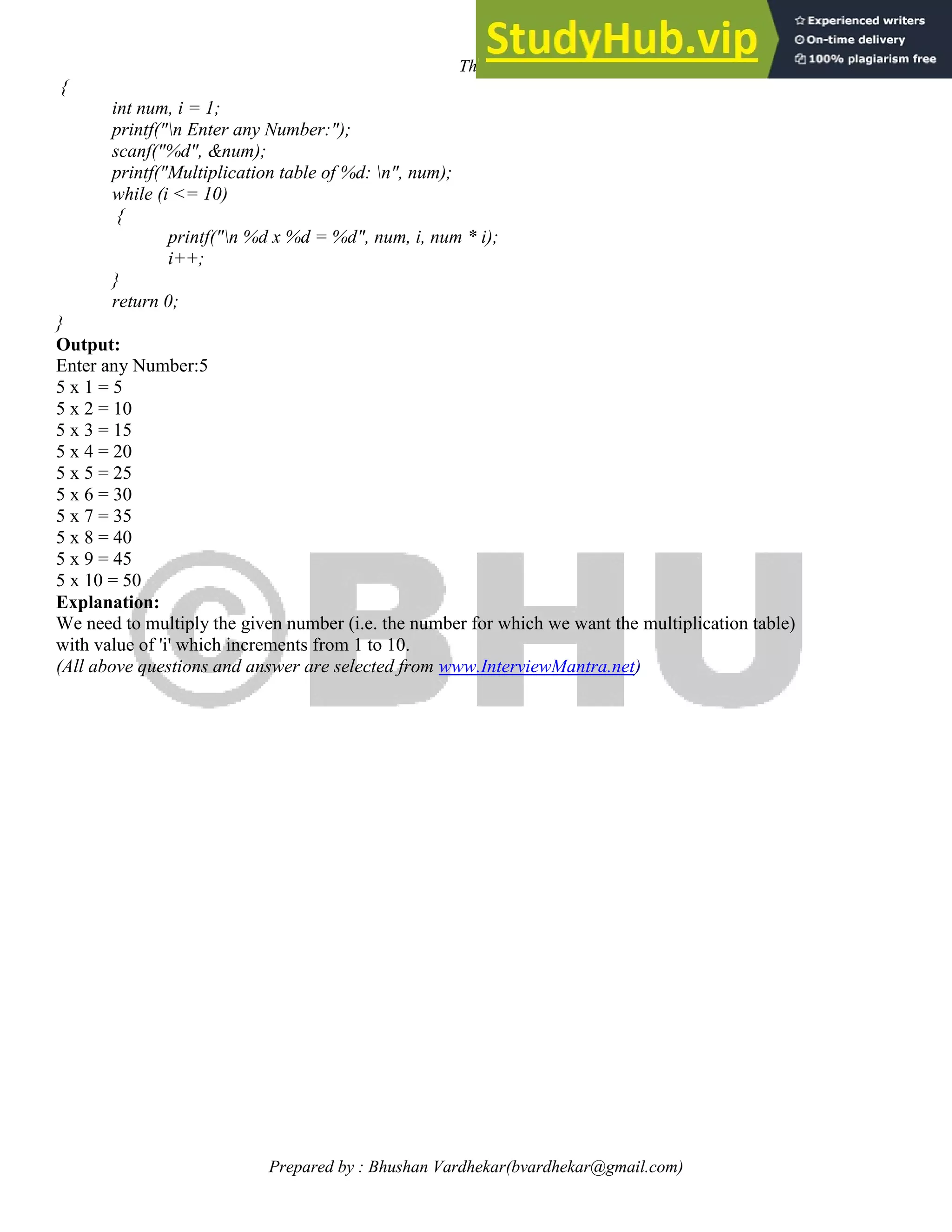
![These notes are prepared according to Pune university syllabus
Prepared by : Bhushan Vardhekar(bvardhekar@gmail.com)
Unit-2: Advanced Features and Interfacing
Miscellaneous and advanced features: command line argument, dynamic memory
allocation, Data files in C, file handling in C.
Graphics in C: graphics-video modes, video adapters, drawing various object on
screen.
Interfacing: interfacing to external hardware, via serial/parallel port using C, applying
C to electronic circuit problems.
Questions and Answer
1. What is the purpose of main() function?
Ans: In C, program execution starts from the main() function. Every C program must contain a main() function.
The main function may contain any number of statements. These statements are executed sequentially in the
order which they are written. The main function can in-turn call other functions. When main calls a function, it
passes the execution control to that function. The function returns control to main when a return statement is
executed or when end of function is reached. In C, the function prototype of the 'main' is one of the following:
int main(); //main with no arguments
int main(int argc, char *argv[]); //main with arguments
The parameters argc and argv respectively give the number and value of the program's command-line
arguments.
Example:
#include <stdio.h>
/* program section begins here */
int main()
{
// opening brace - program execution starts here
printf("Welcome to the world of C");
return 0;
}// closing brace - program terminates here
Output:
Welcome to the world of C
2. Explain command line arguments of main function?
In C, we can supply arguments to 'main' function. The arguments that we pass to main ( ) at command prompt
are called command line arguments. These arguments are supplied at the time of invoking the program.
The main ( ) function can take arguments as: main(int argc, char *argv[]) { }
The first argument argc is known as 'argument counter'. It represents the number of arguments in the command
line. The second argument argv is known as 'argument vector'. It is an array of char type pointers that points to
the command line arguments. Size of this array will be equal to the value of argc.
Example: at the command prompt if we give:
C:> fruit.exe apple mango
then
argc would contain value 3
argv [0] would contain base address of string " fruit.exe" which is the command name that invokes the program.
argv [1] would contain base address of string "apple"
argv [2] would contain base address of string "mango"
here apple and mango are the arguments passed to the program fruit.exe
Program:
#include <stdio.h>](https://image.slidesharecdn.com/advancedcprogrammingnotes-230806153940-22109339/75/Advanced-C-Programming-Notes-35-2048.jpg)
![These notes are prepared according to Pune university syllabus
Prepared by : Bhushan Vardhekar(bvardhekar@gmail.com)
int main(int argc, char *argv[])
{
int n;
printf("Following are the arguments entered in the command line");
for (n = 0; n < argc; n++)
{
printf("n %s", argv[n]);
}
printf("n Number of arguments entered aren %dn", argc);
return 0;
}
Output:
Following are the arguments entered in the command line
C:testproject.exe
apple
mango
Number of arguments entered are
3
3. What are the differences between malloc() and calloc()?
Ans: Allocation of memory at the time of execution is called dynamic memory allocation. It is done using
the standard library functions malloc() and calloc(). It is defined in "stdlib.h".
malloc(): used to allocate required number of bytes in memory at runtime. It takes one argument, viz. size in
bytes to be allocated.
Syntax:
void * malloc(size_t size);
Example:
a = (int*) malloc(4);
4 is the size (in bytes) of memory to be allocated.
calloc(): used to allocate required number of bytes in memory at runtime. It needs two arguments viz.,
1. total number of data and
2. size of each data.
Syntax:
void * calloc(size_t nmemb, size_t size);
Example:
a = (int*) calloc(8, sizeof(int));
Here sizeof indicates the size of the data type and 8 indicates that we want to reserve space for storing 8
integers.
Differences between malloc() and calloc() are:
1. Number of arguments differ.
2. By default, memory allocated by malloc() contains garbage values. Whereas memory allocated by calloc()
contains all zeros.
4. How to use realloc() to dynamically increase size of an already allocated array?
realloc(): This function is used to increase or decrease the size of any dynamic memory which is allocated
using malloc() or calloc() functions.
Syntax: void *realloc(void *ptr, size_t newsize);](https://image.slidesharecdn.com/advancedcprogrammingnotes-230806153940-22109339/75/Advanced-C-Programming-Notes-36-2048.jpg)
![These notes are prepared according to Pune university syllabus
Prepared by : Bhushan Vardhekar(bvardhekar@gmail.com)
The first argument 'ptr' is a pointer to the memory previously allocated by the malloc or calloc functions. The
second argument 'newsize' is the size in bytes, of a new memory region to be allocated by realloc. This value
can be larger or smaller than the previously allocated memory. The realloc function adjusts the old memory
region if newsize is smaller than the size of old memory.
If the newsize is larger than the existing memory size, it increases the size by copying the contents of old
memory region to new memory region. The function then deallocates the old memory region. realloc function is
helpful in managing a dynamic array whose size may change during execution.
Example: a program that reads input from standard input may not know the size of data in advance. In this case,
dynamically allocated array can be used so that it is possible allocate the exact amount of memory using realloc
function.
5. Write a program to delete a specified line from a text file.
In this program, user is asked for a filename he needs to change. User is also asked for the line number that is
to be deleted. The filename is stored in 'filename'. The file is opened and all the data is transferred to another
file except that one line the user specifies to delete.
Program: Program to delete a specific line.
#include <stdio.h>
int main()
{
FILE *fp1, *fp2;
//consider 40 character string to store filename
char filename[40];
char c;
int del_line, temp = 1;
//asks user for file name
printf("Enter file name: ");
//receives file name from user and stores in 'filename'
scanf("%s", filename);
//open file in read mode
fp1 = fopen(filename, "r");
c = getc(fp1);
//until the last character of file is obtained
while (c != EOF)
{
printf("%c", c);
//print current character and read next character
c = getc(fp1);
}
//rewind
rewind(fp1);
printf(" n Enter line number of the line to be deleted:");
//accept number from user.
scanf("%d", &del_line);
//open new file in write mode
fp2 = fopen("copy.c", "w");
c = getc(fp1);
while (c != EOF)
{](https://image.slidesharecdn.com/advancedcprogrammingnotes-230806153940-22109339/75/Advanced-C-Programming-Notes-37-2048.jpg)
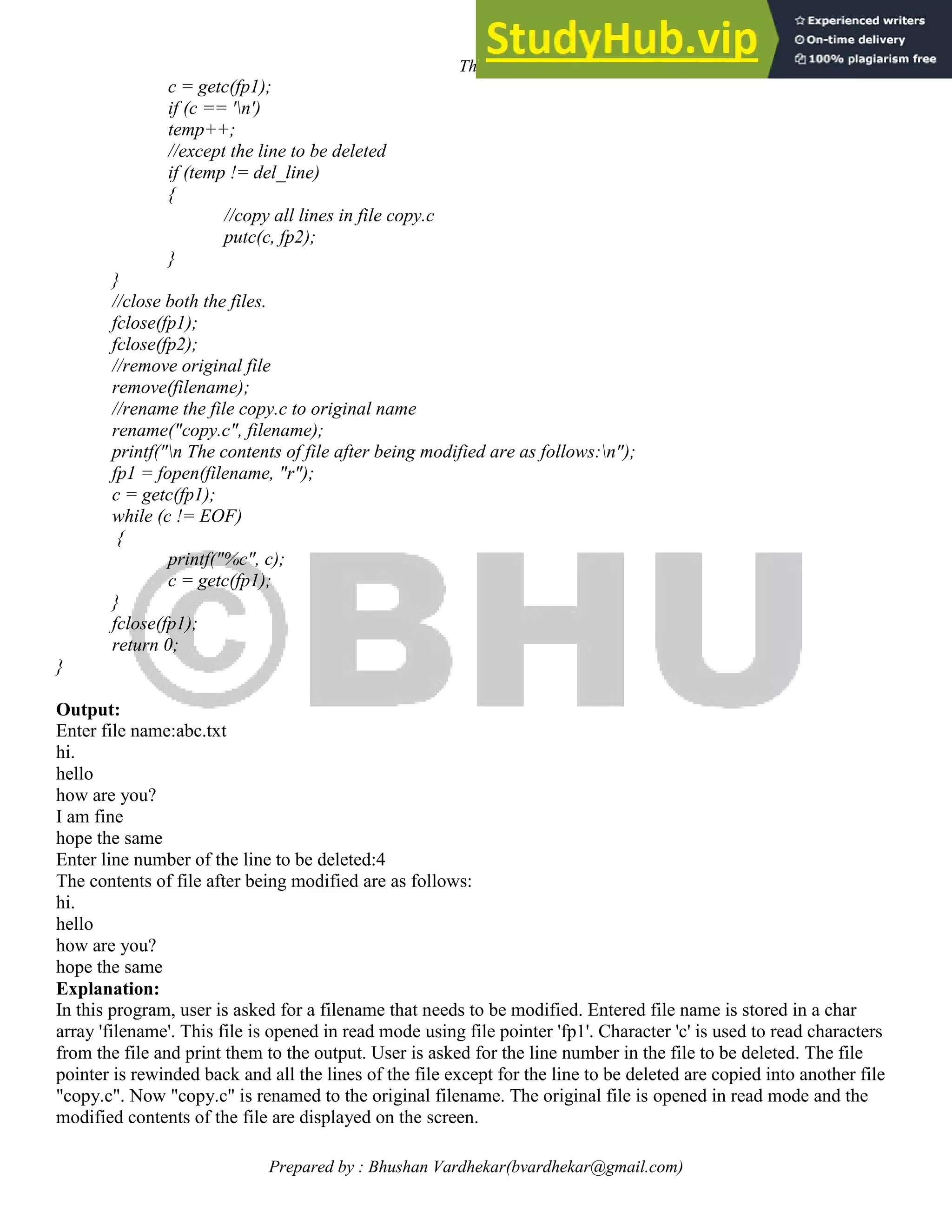
![These notes are prepared according to Pune university syllabus
Prepared by : Bhushan Vardhekar(bvardhekar@gmail.com)
6. Write a program to replace a specified line in a text file.
Program: Program to replace a specified line in a text file.
#include <stdio.h>
int main(void)
{
FILE *fp1, *fp2;
//'filename'is a 40 character string to store filename
char filename[40];
char c;
int del_line, temp = 1;
//asks user for file name
printf("Enter file name: ");
//receives file name from user and stores in 'filename'
scanf("%s", filename);
fp1 = fopen(filename, "r");
//open file in read mode
c = getc(fp1);
//print the contents of file .
while (c != EOF)
{
printf("%c", c);
c = getc(fp1);
}
//ask user for line number to be deleted.
printf(" n Enter line number to be deleted and replaced");
scanf("%d", &del_line);
//take fp1 to start point.
rewind(fp1);
//open copy.c in write mode
fp2 = fopen("copy.c", "w");
c = getc(fp1);
while (c != EOF)
{
if (c == 'n')
{
temp++;
}
//till the line to be deleted comes,copy the content from one file to other
if (temp != del_line)
{
putc(c, fp2);
}
else //when the line to be deleted comes
{
while ((c = getc(fp1)) != 'n')
{
}
//read and skip the line ask for new text
printf("Enter new text");
//flush the input stream](https://image.slidesharecdn.com/advancedcprogrammingnotes-230806153940-22109339/75/Advanced-C-Programming-Notes-39-2048.jpg)
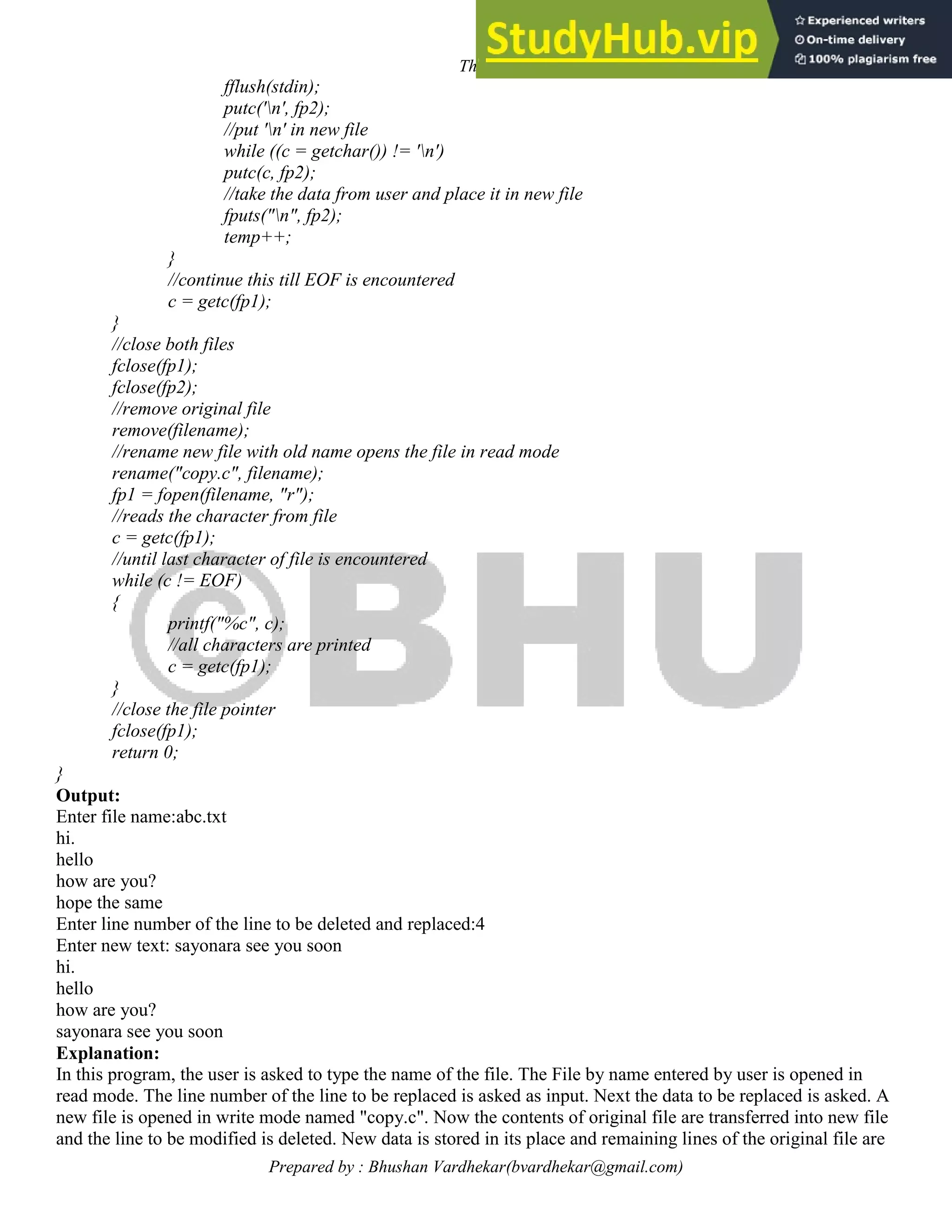
![These notes are prepared according to Pune university syllabus
Prepared by : Bhushan Vardhekar(bvardhekar@gmail.com)
also transferred. The copied file with modified contents is replaced with the original file's name. Both the file
pointers are closed and the original file is again opened in read mode and the contents of the original file is
printed as output.
7. Write a program to find the number of lines in a text file.
Number of lines in a file can be determined by counting the number of new line characters present.
Program: Program to count number of lines in a file.
#include <stdio.h>
int main()
/* Ask for a filename and count number of lines in the file*/
{
//a pointer to a FILE structure
FILE *fp;
int no_lines = 0;
//consider 40 character string to store filename
char filename[40], sample_chr;
//asks user for file name
printf("Enter file name: ");
//receives file name from user and stores in a string named 'filename'
scanf("%s", filename);
//open file in read mode
fp = fopen(filename, "r");
//get character from file and store in sample_chr
sample_chr = getc(fp);
while (sample_chr != EOF)
{
//Count whenever sample_chr is 'n'(new line) is encountered
if (sample_chr == 'n')
{
//increment variable 'no_lines' by 1
no_lines=no_lines+1;
}
//take next character from file.
sample_chr = getc(fp);
}
fclose(fp); //close file.
printf("There are %d lines in %s n", no_lines, filename);
return 0;
}
Output:
Enter file name:abc.txt
There are 4 lines in abc.txt
Explanation:
In this program, name of the file to be read is taken as input. A file by the given name is opened in read-mode
using a File pointer 'fp'. Characters from the file are read into a char variable 'sample_chr' with the help of getc
function. If a new line character('n') is encountered, the integer variable 'no_lines' is incremented. If the
character read into 'sample_char' is not a new line character, next character is read from the file. This process is
continued until the last character of the file(EOF) is encountered. The file pointer is then closed and the total
number of lines is shown as output.](https://image.slidesharecdn.com/advancedcprogrammingnotes-230806153940-22109339/75/Advanced-C-Programming-Notes-41-2048.jpg)
![These notes are prepared according to Pune university syllabus
Prepared by : Bhushan Vardhekar(bvardhekar@gmail.com)
8. Write a C program which asks the user for a number between 1 to 9 and shows the number. If the
user inputs a number out of the specified range, the program should show an error and prompt
the user for a valid input.
Program: Program for accepting a number in a given range.
#include<stdio.h>
int getnumber();
int main()
{
int input = 0;
//call a function to input number from key board
input = getnumber();
//when input is not in the range of 1 to 9,print error message
while (!((input <= 9) && (input >= 1)))
{
printf("[ERROR] The number you entered is out of range");
//input another number
input = getnumber();
}
//this function is repeated until a valid input is given by user.
printf("nThe number you entered is %d", input);
return 0;
}
//this function returns the number given by user
int getnumber()
{
int number;
//asks user for a input in given range
printf("nEnter a number between 1 to 9 n");
scanf("%d", &number);
return (number);
}
Output:
Enter a number between 1 to 9
45
[ERROR] The number you entered is out of range
Enter a number between 1 to 9
4
The number you entered is 4
Explanation:
getfunction() function accepts input from user. 'while' loop checks whether the number falls within range or not
and accordingly either prints the number(If the number falls in desired range) or shows error message(number is
out of range).](https://image.slidesharecdn.com/advancedcprogrammingnotes-230806153940-22109339/75/Advanced-C-Programming-Notes-42-2048.jpg)
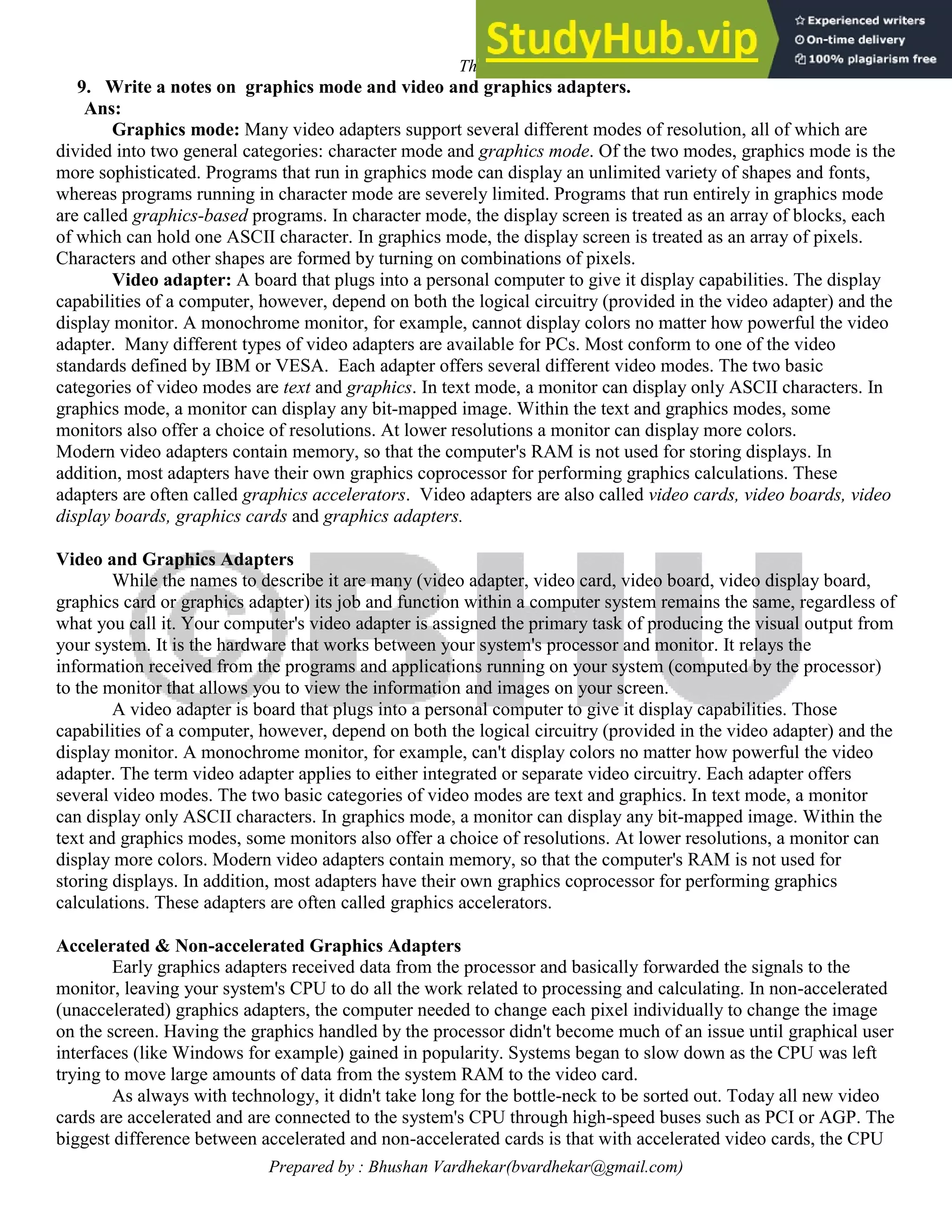
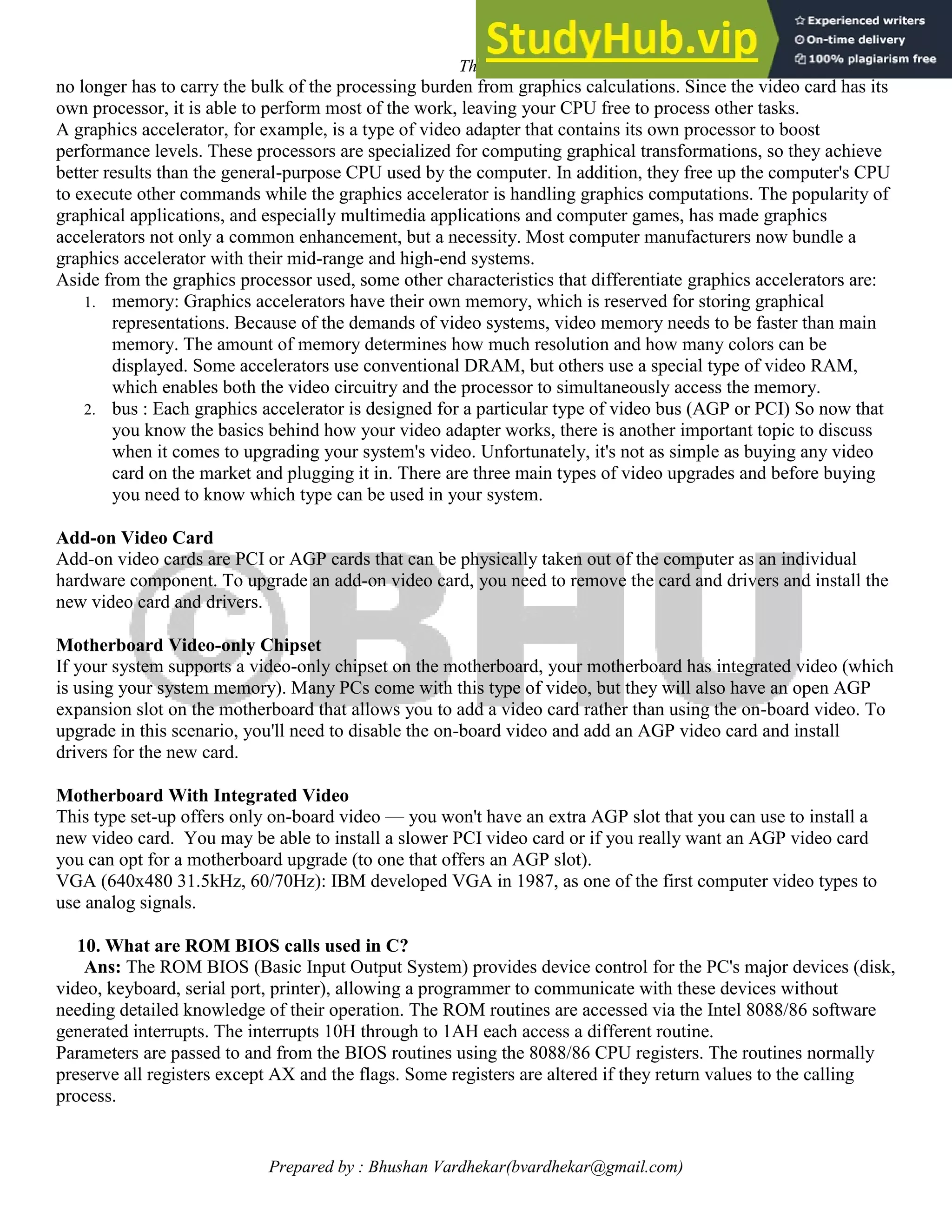
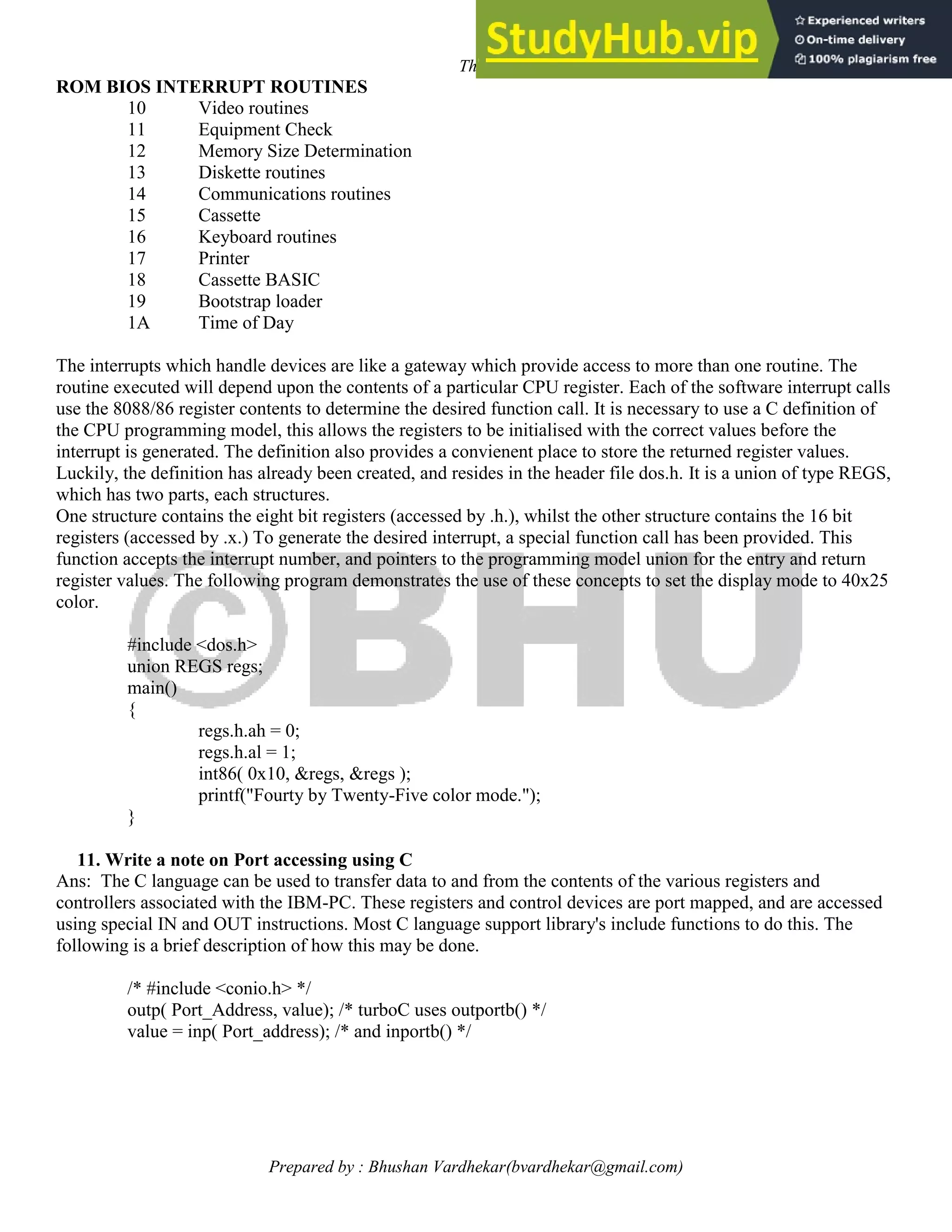
![These notes are prepared according to Pune university syllabus
Prepared by : Bhushan Vardhekar(bvardhekar@gmail.com)
The various devices, and their port values, are shown below,
Port Range Device
00 - 0f DMA Chip 8737
20 - 21 8259 PIC
40 - 43 Timer Chip 8253
60 - 63 PPI 8255 (cassette, sound)
80 - 83 DMA Page registers
200 - 20f Game I/O Adapter
278 - 27f Reserved
2f8 - 2ff COM2
378 - 37f Parallel Printer
3b0 - 3bf Monochrome Display
3d0 - 3df Color Display
3f0 - 3f7 Diskette
3f8 - 3ff COM1
12. Write a C Program to Print All Arguments passed to C Program using Command Line.
Ans:
#include<stdio.h>
int main(int args,char *argv[])
{
int i=0;
for(i=0;i<args;i++)
printf("n%s",argv[i]);
return 0;
}
Output : Carry out following Steps to Run
1. Save Program
2. Compile Program.
3. Run Program.
4. Now Open Command Prompt.
5. Move to the directory where program is saved.
6. Type following command.
C:>TC>BIN>pgm1 Argument is passed…
C:>TC>BIN>pgm1.exe
Argument is passed…
13. Write a C Program to Add two numbers using Command Line Arguments
Ans:
#include<stdio.h>
void main(int argc , char * argv[])
{
int i,sum=0;
if(argc!=3)
{
printf("you have forgot to type numbers.");
exit(1);
}](https://image.slidesharecdn.com/advancedcprogrammingnotes-230806153940-22109339/75/Advanced-C-Programming-Notes-46-2048.jpg)
![These notes are prepared according to Pune university syllabus
Prepared by : Bhushan Vardhekar(bvardhekar@gmail.com)
printf("The sum is : ");
for(i=1;i<argc;i++)
sum = sum + atoi(argv[i]);
printf("%d",sum);
}
Output :
The sum is : 30
Steps to be followed to execute program using Command Line Argument inside Borland C/C++ Compiler :
Step 1 : Write a Program
Step 2 : Open Command Prompt inside Borland C/C++.
Step 3 : Click on DOS Shell.
Step 4 : Inside Command Prompt type this command.
C:TCBIN>add 10 20
Step 5 : Hit Enter , You will get following Output.
C:TCBIN>add 10 20
The sum is : 30
C:TCBIN>
Step 6 : Type ―exit‖ command to return to Turbo C/C++ Screen](https://image.slidesharecdn.com/advancedcprogrammingnotes-230806153940-22109339/75/Advanced-C-Programming-Notes-47-2048.jpg)
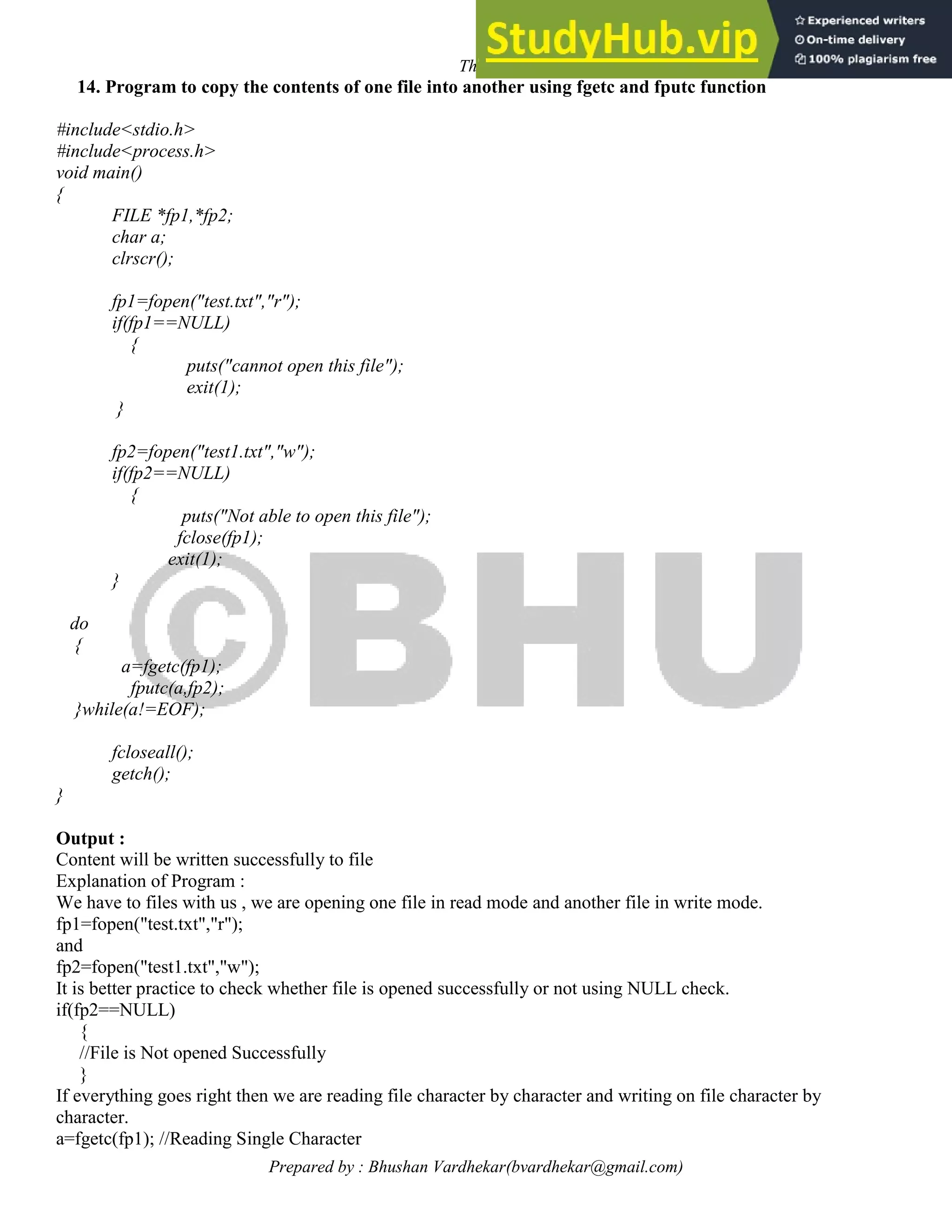

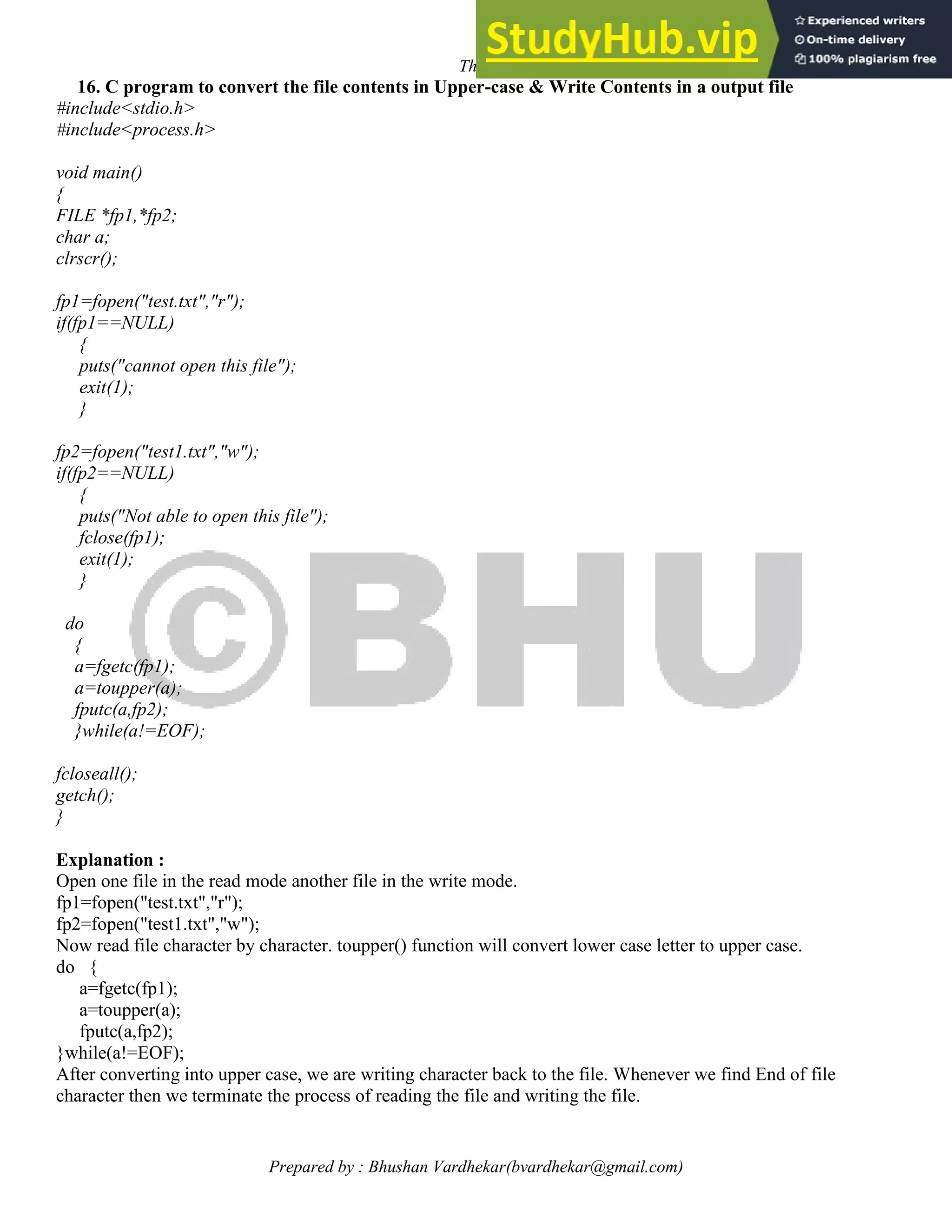
![These notes are prepared according to Pune university syllabus
Prepared by : Bhushan Vardhekar(bvardhekar@gmail.com)
17. C Program to Write on Data File and Read From Data File
#include<stdio.h>
#include<conio.h>
struct stud
{
int roll;
char name[12];
int percent;
}s = {10,"SMJC",80};
void main()
{
FILE *fp;
struct stud s1;
clrscr();
fp = fopen("ip.txt","w");
/* write struct s to file */
fwrite(&s, sizeof(s), 1,fp);
fclose(fp);
fp = fopen("ip.txt","r");
/* read struct s to file */
fread(&s1, sizeof(s1), 1,fp);
fclose(fp);
printf("nRoll : %d",s1.roll);
printf("nName : %s",s1.name);
printf("nPercent : %d",s1.percent);
}
Output :
Roll : 10
Name : SMJC
Percent : 80
18. Program : Copy Text From One File to Other File
#include<stdio.h>
#include<conio.h>
#include<stdlib.h>
void main()
{
FILE *fp1,*fp2;
char ch;
clrscr();
fp1 = fopen("Sample.txt","r");](https://image.slidesharecdn.com/advancedcprogrammingnotes-230806153940-22109339/75/Advanced-C-Programming-Notes-51-2048.jpg)
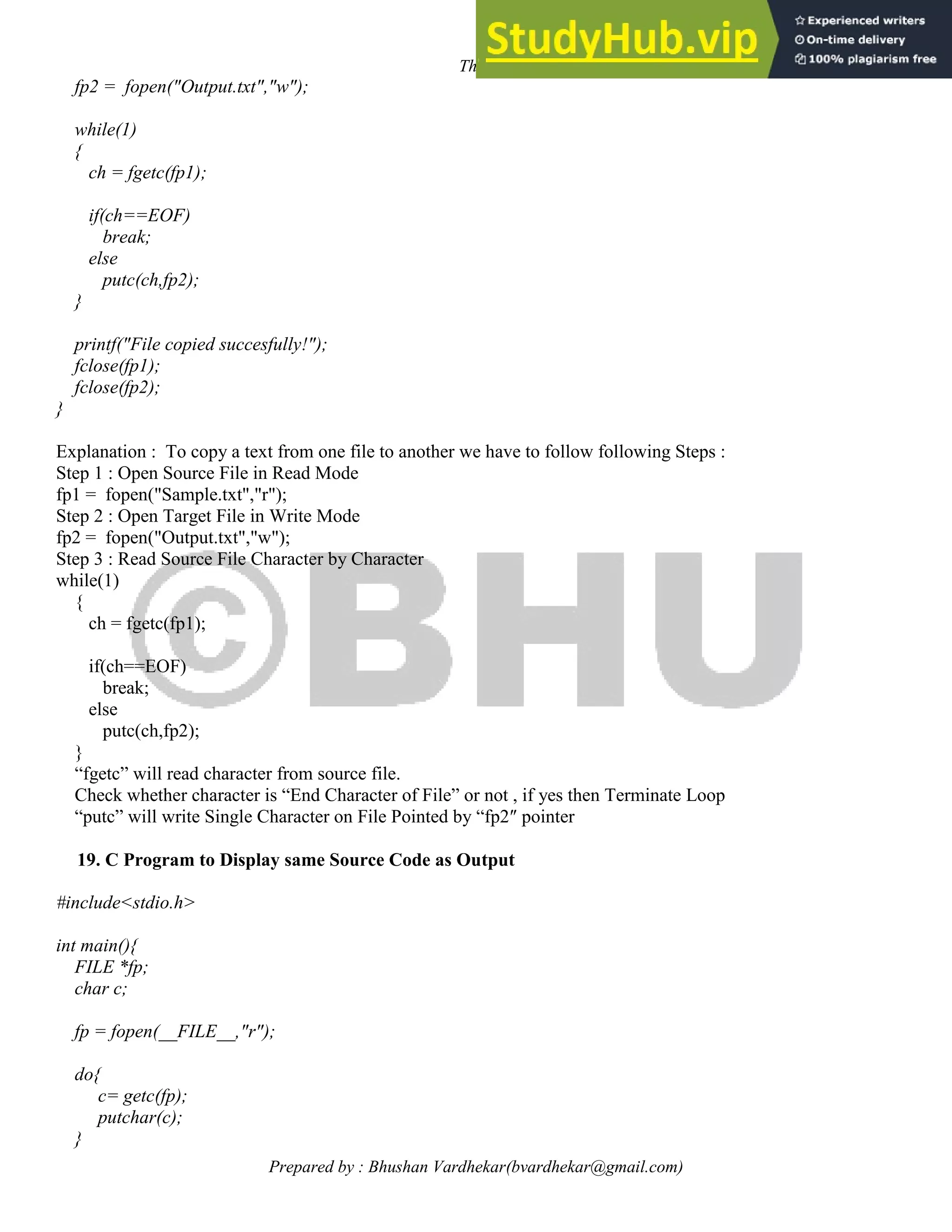
![These notes are prepared according to Pune university syllabus
Prepared by : Bhushan Vardhekar(bvardhekar@gmail.com)
while(c!=EOF);
fclose(fp);
return 0;
}
Output :
#include<stdio.h>
int main(){
FILE *fp;
char c;
fp = fopen(__FILE__,"r");
do{
c= getc(fp);
putchar(c);
}
while(c!=EOF);
fclose(fp);
return 0;
}
Explanation :
fp = fopen(__FILE__,"r");
[arrowlist]
__FILE__ is Standard Predefined Macros in C Programming.
This macro will expand to the name of current file path.
Suppose we have saved this source code at path -
[/arrowlist]
c://tc/bin/file1.c
then
fp = fopen(__FILE__,"r");
will be expanded as -
fp = fopen("c://tc/bin/file1.c","r");
20. Program : To find equivalent capacitance of Parallel combination of capacitive circuit
#include<stdio.h>
#include<conio.h>
int main()
{
float c[10],num,Cp=0;](https://image.slidesharecdn.com/advancedcprogrammingnotes-230806153940-22109339/75/Advanced-C-Programming-Notes-53-2048.jpg)
![These notes are prepared according to Pune university syllabus
Prepared by : Bhushan Vardhekar(bvardhekar@gmail.com)
int i;
clrscr();
printf("Enter the number of Capacitors : ");
scanf("%f",&num);
printf("nEnter Value of Each Capacitor : n");
for(i=0;i<num;i++)
{
printf("nC%d : ",i+1);
scanf("%f",&c[i]);
}
for(i=0;i<num;i++)
{
Cp = Cp + c[i];
}
printf("nEquivalent Parallel Capacitance : %f mFarad",Cp);
getch();
}
Output :
Enter the number of Capacitors : 3
Enter Value of Each Capacitor :
C1 : 1.2
C2 : 1.3
C3 : 1.4
Equivalent Parallel Capacitance : 3.900000 mFarad
21. Program : To find equivalent capacitance of series combination of capacitive circuit
#include<stdio.h>
#include<conio.h>
void main()
{
float c[10],num,Cs=0;
int i;
clrscr();
printf("Enter the number of Capacitors : ");
scanf("%f",&num);
printf("nEnter Value of Each Capacitor : n");
for(i=0;i<num;i++)
{
printf("nC%d : ",i+1);
scanf("%f",&c[i]);](https://image.slidesharecdn.com/advancedcprogrammingnotes-230806153940-22109339/75/Advanced-C-Programming-Notes-54-2048.jpg)
![These notes are prepared according to Pune university syllabus
Prepared by : Bhushan Vardhekar(bvardhekar@gmail.com)
}
for(i=0;i<num;i++)
{
Cs = Cs + (1.0/c[i]);
}
Cs = 1.0 / Cs;
printf("nEquivalent Series Capacitance : %f mFarad",Cs);
getch();
}
Enter the number of Capacitors : 3
Enter Value of Each Capacitor :
C1 : 1
C2 : 1
C3 : 1
Equivalent Series Capacitance : 0.333333 mFarad
22. Program : Program To find equivalent resistance of Parallel combination of resistive circuits
#include<stdio.h>
#include<conio.h>
int main()
{
int r[10],num,i,Rs=0;
clrscr();
printf("Enter the number of Resistances : ");
scanf("%d",&num);
printf("nEnter Value of Each Resistance : n");
for(i=0;i<num;i++)
{
printf("nR%d : ",i+1);
scanf("%d",&r[i]);
}
for(i=0;i<num;i++)
{
Rs = Rs + r[i];
}
printf("nEquivalent Series Resistance : %d Kohm",Rs);
getch();
}
Output :
Enter the number of Resistances : 3
Enter Value of Each Resistance :
R1 : 4](https://image.slidesharecdn.com/advancedcprogrammingnotes-230806153940-22109339/75/Advanced-C-Programming-Notes-55-2048.jpg)
![These notes are prepared according to Pune university syllabus
Prepared by : Bhushan Vardhekar(bvardhekar@gmail.com)
R2 : 2
R3 : 3
Equivalent Parallel Resistance : 0.923077 Kohm
23. Program : To find equivalent resistance of series combination of resistive circuits
#include<stdio.h>
#include<conio.h>
int main()
{
int r[10],num,i,Rs=0;
clrscr();
printf("Enter the number of Resistances : ");
scanf("%d",&num);
printf("nEnter Value of Each Resistance : n");
for(i=0;i<num;i++)
{
printf("nR%d : ",i+1);
scanf("%d",&r[i]);
}
for(i=0;i<num;i++)
{
Rs = Rs + r[i];
}
printf("nEquivalent Series Resistance : %d Kohm",Rs);
getch();
}
Output :
Enter the number of Resistances : 5
Enter Value of Each Resistance :
R1 : 3
R2 : 2
R3 : 3
R4 : 2
R5 : 1
Equivalent Series Resistance : 11 Kohm
24. C Program to display mouse pointer in textmode
#include<stdio.h>
#include<conio.h>
#include<dos.h>
int initmouse();
void showmouseptr();
union REGS i, o;
main()
{
int status;
status = initmouse();](https://image.slidesharecdn.com/advancedcprogrammingnotes-230806153940-22109339/75/Advanced-C-Programming-Notes-56-2048.jpg)
